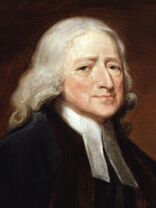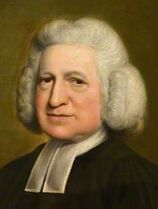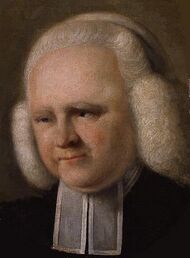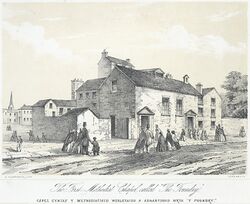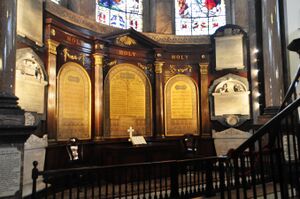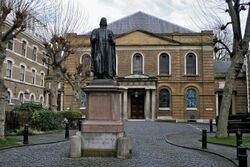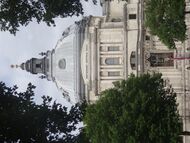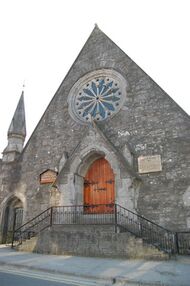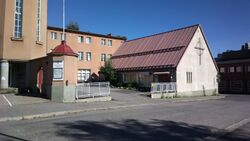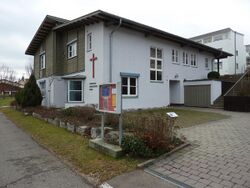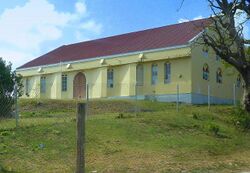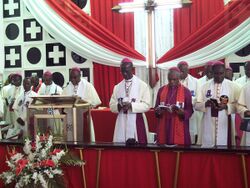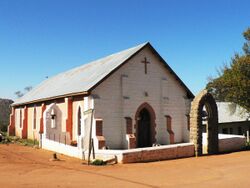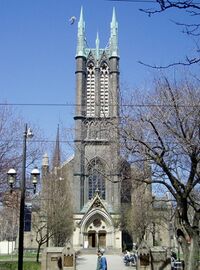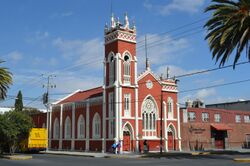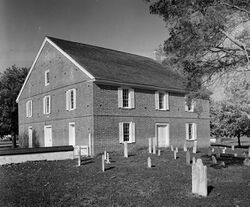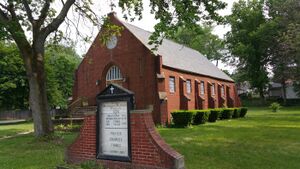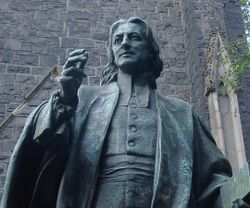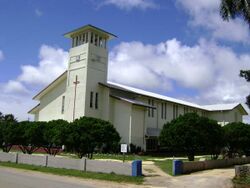Methodism
Topic: Religion
 From HandWiki - Reading time: 76 min
From HandWiki - Reading time: 76 min
Methodism, also called the Methodist movement, is a group of historically related denominations of Protestant Christianity whose origins, doctrine and practice derive from the life and teachings of John Wesley. George Whitefield and John's brother Charles Wesley were also significant early leaders in the movement. They were named Methodists for "the methodical way in which they carried out their Christian faith".[1][2] Methodism originated as a revival movement within Anglicanism originating out of the Church of England in the 18th century and became a separate denomination after Wesley's death. The movement spread throughout the British Empire, the United States and beyond because of vigorous missionary work,[3] and today has about 80 million adherents worldwide.[nb 1][4]
Wesleyan theology, which is upheld by the Methodist churches, focuses on sanctification and the transforming effect of faith on the character of a Christian. Distinguishing doctrines include the new birth,[5] assurance,[6][7] imparted righteousness, the possibility of entire sanctification,[8] and the works of piety. Scripture is considered a primary authority, but Methodists also look to Christian tradition, including the historic creeds. Most Methodists teach that Jesus Christ, the Son of God, died for all of humanity and that salvation is achievable for all.[9] This is an Arminian doctrine,[nb 2] as opposed to the Calvinist position that God has pre-ordained the salvation of a select group of people. However, Whitefield and several other early leaders of the movement were considered Calvinistic Methodists and held to the Calvinist position.
The movement has a wide variety of forms of worship, ranging from high church to low church in liturgical usage, in addition to tent revivals and camp meetings held at certain times of the year.[10] Denominations that descend from the British Methodist tradition are generally less ritualistic, while American Methodism is more so, the United Methodist Church in particular.[11] Methodism is known for its rich musical tradition, and Charles Wesley was instrumental in writing much of the hymnody of Methodism.[12]
In addition to evangelism, Methodism emphasizes charity and support for the sick, the poor, and the afflicted through works of mercy.[13][14] These ideals, the Social Gospel, are put into practice by the establishment of hospitals, orphanages, soup kitchens, and schools to follow Christ's command to spread the gospel and serve all people.[15][16][13] Methodists are historically known for their adherence to the doctrine of nonconformity to the world, reflected by their traditional standards of a commitment to sobriety, prohibition of gambling, regular attendance at class meetings, and weekly observance of the Friday fast.[17][18]
Early Methodists were drawn from all levels of society, including the aristocracy,[nb 3] but the Methodist preachers took the message to labourers and criminals who tended to be left outside organized religion at that time. In Britain, the Methodist Church had a major effect in the early decades of the developing working class (1760–1820).[20] In the United States, it became the religion of many slaves, who later formed black churches in the Methodist tradition.[21]
Origins
The Methodist revival began in England with a group of men, including John Wesley (1703–1791) and his younger brother Charles (1707–1788), as a movement within the Church of England in the 18th century.[22][23] The Wesley brothers founded the "Holy Club" at the University of Oxford, where John was a fellow and later a lecturer at Lincoln College.[24] The club met weekly and they systematically set about living a holy life. They were accustomed to receiving Communion every week, fasting regularly, abstaining from most forms of amusement and luxury and frequently visited the sick and the poor, as well as prisoners. The fellowship were branded as "Methodist" by their fellow students because of the way they used "rule" and "method" to go about their religious affairs.[25] John, who was leader of the club, took the attempted mockery and turned it into a title of honour.[25][26]
In 1735, at the invitation of the founder of the Georgia Colony, General James Oglethorpe, both John and Charles Wesley set out for America to be ministers to the colonists and missionaries to the Native Americans.[27] Unsuccessful in their work, the brothers returned to England conscious of their lack of genuine Christian faith. They looked for help to Peter Boehler and other members of the Moravian Church. At a Moravian service in Aldersgate on 24 May 1738, John experienced what has come to be called his evangelical conversion, when he felt his "heart strangely warmed".[28] He records in his journal: "I felt I did trust in Christ, Christ alone, for salvation; and an assurance was given me that He had taken away my sins, even mine, and saved me from the law of sin and death."[29] Charles had reported a similar experience a few days previously. Considering this a pivotal moment, Daniel L. Burnett writes: "The significance of [John] Wesley's Aldersgate Experience is monumental ... Without it the names of Wesley and Methodism would likely be nothing more than obscure footnotes in the pages of church history."[30]
The Wesley brothers immediately began to preach salvation by faith to individuals and groups, in houses, in religious societies, and in the few churches which had not closed their doors to evangelical preachers.[31] John Wesley came under the influence of the Dutch theologian Jacobus Arminius (1560–1609). Arminius had rejected the Calvinist teaching that God had pre-ordained an elect number of people to eternal bliss while others perished eternally. Conversely, George Whitefield (1714–1770), Howell Harris (1714–1773),[32] and Selina Hastings, Countess of Huntingdon (1707–1791)[33] were notable for being Calvinistic Methodists.
George Whitefield, returning from his own mission in Georgia, joined the Wesley brothers in what was rapidly to become a national crusade.[31] Whitefield, who had been a fellow student of the Wesleys and prominent member of the Holy Club at Oxford, became well known for his unorthodox, itinerant ministry, in which he was dedicated to open-air preaching – reaching crowds of thousands.[31] A key step in the development of John Wesley's ministry was, like Whitefield, to preach in fields, collieries and churchyards to those who did not regularly attend parish church services.[31] Accordingly, many Methodist converts were those disconnected from the Church of England; Wesley remained a cleric of the Established Church and insisted that Methodists attend their local parish church as well as Methodist meetings because only an ordained minister could perform the sacraments of Baptism and Holy Communion.[1]
Faced with growing evangelistic and pastoral responsibilities, Wesley and Whitefield appointed lay preachers and leaders.[31] Methodist preachers focused particularly on evangelising people who had been "neglected" by the established Church of England. Wesley and his assistant preachers organized the new converts into Methodist societies.[31] These societies were divided into groups called classes – intimate meetings where individuals were encouraged to confess their sins to one another and to build up each other. They also took part in love feasts which allowed for the sharing of testimony, a key feature of early Methodism.[34] Growth in numbers and increasing hostility impressed upon the revival converts a deep sense of their corporate identity.[31] Three teachings that Methodists saw as the foundation of Christian faith were:
- People are all, by nature, "dead in sin".
- They are justified by faith alone.
- Faith produces inward and outward holiness.[35]
Wesley's organisational skills soon established him as the primary leader of the movement. Whitefield was a Calvinist, whereas Wesley was an outspoken opponent of the doctrine of predestination.[36] Wesley argued (against Calvinist doctrine) that Christians could enjoy a second blessing – entire sanctification (Christian perfection) in this life: loving God and their neighbours, meekness and lowliness of heart and abstaining from all appearance of evil.[5][37] These differences put strains on the alliance between Whitefield and Wesley,[36] with Wesley becoming hostile toward Whitefield in what had been previously close relations. Whitefield consistently begged Wesley not to let theological differences sever their friendship and, in time their friendship was restored, though this was seen by many of Whitefield's followers to be a doctrinal compromise.[38]
Many clergy in the established church feared that new doctrines promulgated by the Methodists, such as the necessity of a new birth for salvation – the first work of grace, of justification by faith and of the constant and sustained action of the Holy Spirit upon the believer's soul, would produce ill effects upon weak minds.[39] Theophilus Evans, an early critic of the movement, even wrote that it was "the natural Tendency of their Behaviour, in Voice and Gesture and horrid Expressions, to make People mad". In one of his prints, William Hogarth likewise attacked Methodists as "enthusiasts" full of "Credulity, Superstition, and Fanaticism".[39] Other attacks against the Methodists were physically violent – Wesley was nearly murdered by a mob at Wednesbury in 1743.[40] The Methodists responded vigorously to their critics and thrived despite the attacks against them.[41]
Initially, the Methodists merely sought reform within the Church of England (Anglicanism), but the movement gradually departed from that Church. George Whitefield's preference for extemporaneous prayer rather than the fixed forms of prayer in the Book of Common Prayer, in addition to his insistence on the necessity of the new birth, set him at odds with Anglican clergy.[42]
As Methodist societies multiplied, and elements of an ecclesiastical system were, one after another, adopted, the breach between John Wesley and the Church of England gradually widened. In 1784, Wesley responded to the shortage of priests in the American colonies due to the American Revolutionary War by ordaining preachers for America with power to administer the sacraments.[43] Wesley's actions precipitated the split between American Methodists and the Church of England (which held that only bishops could ordain people to ministry).[44]
With regard to the position of Methodism within Christendom, "John Wesley once noted that what God had achieved in the development of Methodism was no mere human endeavor but the work of God. As such it would be preserved by God so long as history remained."[45] Calling it "the grand depositum" of the Methodist faith, Wesley specifically taught that the propagation of the doctrine of entire sanctification was the reason that God raised up the Methodists in the world.[8][46] In light of this, Methodists traditionally promote the motto "Holiness unto the Lord".[2]
The influence of Whitefield and Lady Huntingdon on the Church of England was a factor in the founding of the Free Church of England in 1844. At the time of Wesley's death there were over 500 Methodist preachers in British colonies and the United States.[31] Total membership of the Methodist societies in Britain was recorded as 56,000 in 1791, rising to 360,000 in 1836 and 1,463,000 by the national census of 1851.[47]
Early Methodism experienced a radical and spiritual phase that allowed women authority in church leadership. The role of the woman preacher emerged from the sense that the home should be a place of community care and should foster personal growth. Methodist women formed a community that cared for the vulnerable, extending the role of mothering beyond physical care. Women were encouraged to testify their faith. However the centrality of women's role sharply diminished after 1790 as Methodist churches became more structured and more male dominated.[48]
The Wesleyan Education Committee, which existed from 1838 to 1902, has documented the Methodist Church's involvement in the education of children. At first most effort was placed in creating Sunday Schools but in 1836 the British Methodist Conference gave its blessing to the creation of "Weekday schools".[49][50]
Methodism spread throughout the British Empire and, mostly through Whitefield's preaching during what historians call the First Great Awakening, in colonial America. After Whitefield's death in 1770, however, American Methodism entered a more lasting Wesleyan and Arminian phase of development.[51]
Theology
All may be saved.
All may know themselves saved.
All may be saved to the uttermost.
Catechism for the Use of the People Called Methodists.[52]:40
Many Methodist bodies, such as the African Methodist Episcopal Church and the United Methodist Church, base their doctrinal standards on the Articles of Religion,[53] John Wesley's abridgment of the Thirty-nine Articles of the Church of England that excised its Calvinist features.[54] Some Methodist denominations also publish catechisms, which concisely summarise Christian doctrine.[52] Methodists generally accept the Apostles' Creed and the Nicene Creed as declarations of shared Christian faith.[52]:30–33[55] Methodism also affirms the traditional Christian belief in the triune Godhead (Father, Son and Holy Spirit) as well as the orthodox understanding of the person of Jesus Christ as God incarnate who is both fully divine and fully human.[56] Methodism emphasizes doctrines that indicate the power of the Holy Spirit to strengthen the faith of believers and to transform their personal lives.[57]
Methodism is broadly evangelical in doctrine and is characterized by Wesleyan theology;[58] John Wesley is studied by Methodists for his interpretation of church practice and doctrine.[52]:38 At its heart, the theology of John Wesley stressed the life of Christian holiness: to love God with all one's heart, mind, soul and strength and to love one's neighbour as oneself.[59][60] One popular expression of Methodist doctrine is in the hymns of Charles Wesley.[61] Since enthusiastic congregational singing was a part of the early evangelical movement, Wesleyan theology took root and spread through this channel.[62][63] Martin V. Clarke, who documented the history of Methodist hymnody, states:
Theologically and doctrinally, the content of the hymns has traditionally been a primary vehicle for expressing Methodism's emphasis on salvation for all, social holiness, and personal commitment, while particular hymns and the communal act of participating in hymn singing have been key elements in the spiritual lives of Methodists.[64]
Salvation
Wesleyan Methodists identify with the Arminian conception of free will, as opposed to the theological determinism of absolute predestination.[65][nb 2] Methodism teaches that salvation is initiated when one chooses to respond to God, who draws the individual near to him (the Wesleyan doctrine of prevenient grace), thus teaching synergism.[69][70] Methodists interpret Scripture as teaching that the saving work of Jesus Christ is for all people (unlimited atonement) but effective only to those who respond and believe, in accordance with the Reformation principles of sola gratia (grace alone) and sola fide (faith alone).[71] John Wesley taught four key points fundamental to Methodism:
- A person is free not only to reject salvation but also to accept it by an act of free will.
- All people who are obedient to the gospel according to the measure of knowledge given them will be saved.
- The Holy Spirit assures a Christian that they are justified by faith in Jesus (assurance of faith).[6][72]
- Christians in this life are capable of Christian perfection and are commanded by God to pursue it.[73]
After the first work of grace (the new birth),[5] Methodist soteriology emphasizes the importance of the pursuit of holiness in salvation,[74] a concept best summarized in a quote by Methodist evangelist Phoebe Palmer who stated that "justification would have ended with me had I refused to be holy."[75] Thus, for Methodists, "true faith...cannot subsist without works".[76] Methodism, inclusive of the holiness movement, thus teaches that "justification [is made] conditional on obedience and progress in sanctification",[75] emphasizing "a deep reliance upon Christ not only in coming to faith, but in remaining in the faith".[77] John Wesley taught that the keeping of the moral law contained in the Ten Commandments,[78] as well as engaging in the works of piety and the works of mercy, were "indispensable for our sanctification".[76]
Methodists also believe in the second work of grace – Christian perfection, also known as entire sanctification, which removes original sin and makes the believer holy.[5] John Wesley explained, "entire sanctification, or Christian perfection, is neither more nor less than pure love; love expelling sin, and governing both the heart and life of a child of God. The Refiner's fire purges out all that is contrary to love."[79][80]
Methodist churches teach that apostasy can occur through a loss of faith or through sinning.[81][82] If a person backslides but later decides to return to God, he or she must confess his or her sins and be entirely sanctified again (the Arminian doctrine of conditional security).[83][84][85]
Sacraments
Methodists hold that sacraments are sacred acts of divine institution. Methodism has inherited its liturgy from Anglicanism, although Wesleyan theology tends to have a stronger "sacramental emphasis" than that held by evangelical Anglicans.[86]
In common with most Protestants, Methodists recognize two sacraments as being instituted by Christ: Baptism and Holy Communion (also called the Lord's Supper).[87] Most Methodist churches practice infant baptism, in anticipation of a response to be made later (confirmation), as well as baptism of believing adults.[88] The Catechism for the Use of the People Called Methodists states that, "[in Holy Communion] Jesus Christ is present with his worshipping people and gives himself to them as their Lord and Saviour".[52]:26 In the United Methodist Church, the explanation of how Christ's presence is made manifest in the elements (bread and wine) is described as a "Holy Mystery".[89]
Methodist churches generally recognize sacraments to be a means of grace.[90] John Wesley held that God also imparted grace by other established means such as public and private prayer, Scripture reading, study and preaching, public worship, and fasting; these constitute the works of piety.[91] Wesley considered means of grace to be "outward signs, words, or actions ... to be the ordinary channels whereby [God] might convey to men, preventing [i.e., preparing], justifying or sanctifying grace".[92] Specifically Methodist means, such as the class meetings, provided his chief examples for these prudential means of grace.[93]
Sources of teaching
American Methodist theologian Albert Outler, in assessing John Wesley's own practices of theological reflection, proposes a methodology termed the "Wesleyan Quadrilateral".[94] Wesley's Quadrilateral is referred to in Methodism as "our theological guidelines" and is taught to its ministers (clergy) in seminary as the primary approach to interpreting Scripture and gaining guidance for moral questions and dilemmas faced in daily living.[95]:76–88
Traditionally, Methodists declare the Bible (Old and New Testaments) to be the only divinely inspired Scripture and the primary source of authority for Christians.[96] The historic Methodist understanding of Scripture is based on the superstructure of Wesleyan covenant theology.[97] Methodists also make use of tradition, drawing primarily from the teachings of the Church Fathers, as a source of authority. Tradition may serve as a lens through which Scripture is interpreted. Theological discourse for Methodists almost always makes use of Scripture read inside the wider theological tradition of Christianity.[98][99]
John Wesley contended that a part of the theological method would involve experiential faith.[94] In other words, truth would be vivified in personal experience of Christians (overall, not individually), if it were really truth. And every doctrine must be able to be defended rationally. He did not divorce faith from reason. By reason, one asks questions of faith and seeks to understand God's action and will. Tradition, experience and reason, however, were subject always to Scripture, Wesley argued, because only there is the Word of God revealed "so far as it is necessary for our salvation."[95]:77
Prayer, worship, and liturgy
Early Methodism was known for its "almost monastic rigors, its living by rule, [and] its canonical hours of prayer".[100] It inherited from its Anglican patrimony the rubrics of reciting the Daily Office, which Methodist Christians were expected to pray.[101] The first prayer book of Methodism, The Sunday Service of the Methodists with other occasional Services thus included the canonical hours of both Morning Prayer and Evening Prayer; these two fixed prayer times were observed everyday in early Christianity, individually on weekdays and corporately on the Lord's Day.[101][102] Later Methodist liturgical books, such as the Methodist Worship Book (1999) provide for Morning Prayer and Evening Prayer to be prayed daily; the United Methodist Church encourages its communicants to pray the canonical hours as "one of the essential practices" of being a disciple of Jesus.[103][104] Some Methodist religious orders publish the Daily Office to be used for that community, for example, The Book of Offices and Services of The Order of Saint Luke contains the canonical hours to be prayed traditionally at seven fixed prayer times: Lauds (6 am), Terce (9 am), Sext (12 pm), None (3 pm), Vespers (6 pm), Compline (9 pm) and Vigil (12 am).[105]
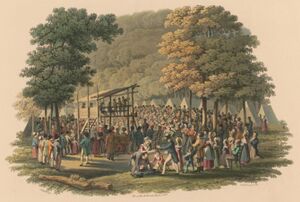
With respect to public worship, Methodism was endowed by the Wesley brothers with worship characterised by a twofold practice: the ritual liturgy of the Book of Common Prayer on the one hand and the non-ritualistic preaching service on the other.[106] This twofold practice became distinctive of Methodism because worship in the Church of England was based, by law, solely on the Book of Common Prayer and worship in the Nonconformist churches was almost exclusively that of "services of the word", i.e. preaching services, with Holy Communion being observed infrequently. John Wesley's influence meant that, in Methodism, the two practices were combined, a situation which remains characteristic of the denomination.[106][107] The Lovefeast, traditionally practiced quarterly, was another practice that characterized early Methodism as John Wesley taught that it was an apostolic ordinance.[108] Worship, hymnology, devotional and liturgical practices in Methodism were also influenced by Lutheran Pietism and, in turn, Methodist worship became influential in the Holiness movement.[109]
In America, the United Methodist Church and Free Methodist Church, as well as the Primitive Methodist Church and Wesleyan Methodist Church, have a wide variety of forms of worship, ranging from high church to low church in liturgical usage. When the Methodists in America were separated from the Church of England because of the American Revolution, John Wesley provided a revised version of the Book of Common Prayer called The Sunday Service of the Methodists; With Other Occasional Services (1784).[110][111] Today, the primary liturgical books of the United Methodist Church are The United Methodist Hymnal and The United Methodist Book of Worship (1992). Congregations employ its liturgy and rituals as optional resources, but their use is not mandatory. These books contain the liturgies of the church that are generally derived from Wesley's Sunday Service and from the 20th-century liturgical renewal movement.
The British Methodist Church is less ordered or liturgical in worship. It makes use of the Methodist Worship Book (similar to the Church of England's Common Worship), containing worship services (liturgies) and rubrics for the celebration of other rites, such as marriage. The Worship Book is also ultimately derived from Wesley's Sunday Service.[112]
A unique feature of American Methodism has been the observance of the season of Kingdomtide, encompassing the last 13 weeks before Advent, thus dividing the long season after Pentecost into two segments. During Kingdomtide, Methodist liturgy has traditionally emphasized charitable work and alleviating the suffering of the poor.[113]
A second distinctive liturgical feature of Methodism is the use of Covenant Services. Although practice varies between national churches, most Methodist churches annually follow the call of John Wesley for a renewal of their covenant with God. It is common, in British Methodism, for each congregation to hold a Covenant Service on the first convenient Sunday of the year. Wesley's covenant prayer is still used, with minor modification, in the order of service:
Christ has many services to be done. Some are easy, others are difficult. Some bring honour, others bring reproach. Some are suitable to our natural inclinations and temporal interests, others are contrary to both ... Yet the power to do all these things is given to us in Christ, who strengthens us. ...I am no longer my own but yours. Put me to what you will, rank me with whom you will; put me to doing, put me to suffering; let me be employed for you or laid aside for you, exalted for you or brought low for you; let me be full, let me be empty, let me have all things, let me have nothing; I freely and wholeheartedly yield all things to your pleasure and disposal.[103]:290
As Wesley advocated outdoor evangelism, revival services are a traditional worship practice of Methodism that are often held in churches, as well as at camp meetings, brush arbor revivals, and tent revivals.[114][115][116]
Membership
Traditionally, Methodist connexions descending from the tradition of the Methodist Episcopal Church have a probationary period of six months before an individual is admitted into church membership as a full member of a congregation.[17] Given the wide attendance at Methodist revival meetings, many people started to attend Methodist services of worship regularly, though they had not yet committed to membership.[17] When they made that commitment, becoming a probationer was the first step and during this period, probationers "receive additional instruction and provide evidence of the seriousness of their faith and willingness to abide by church discipline before being accepted into full membership."[17] In addition to this, to be a probationary member of a Methodist congregation, a person traditionally requires an "earnest desire to be saved from [one's] sins".[17] In the historic Methodist system, probationers were eligible to become members of class meetings, where they could be further discipled in their faith.[17]
Catechisms such as The Probationer's Handbook, authored by minister Stephen O. Garrison, have been used by probationers to learn the Methodist faith.[117] After six months, probationers were examined before the Leaders and Stewards' Meeting (which consisted of Class Leaders and Stewards) where they were to provide "satisfactory assurance both of the correctness of his faith and of his willingness to observe and keep the rules of the church."[17] If probationers were able to do this, they were admitted as full members of the congregation by the pastor.[17]
Full members of a Methodist congregation "were obligated to attend worship services on a regular basis" and "were to abide by certain moral precepts, especially as they related to substance use, gambling, divorce, and immoral pastimes."[17] This practice continues in certain Methodist connexions, such as the Lumber River Conference of the Holiness Methodist Church, in which probationers must be examined by the pastor, class leader, and board for full membership, in addition to being baptized.[118] The same structure is found in the African Methodist Episcopal Zion Church, which teaches:[119]
In order that we may not admit improper persons into our church, great care be taken in receiving persons on probation, and let not one be so received or enrolled who does not give satisfactory evidence of his/her desire to flee the wrath to come and to be saved from his/her sins. Such a person satisfying us in these particulars may be received into our church on six months probation; but shall not be admitted to full membership until he/she shall have given satisfactory evidence of saving faith in the Lord Jesus Christ.
– ¶89, The Doctrine and Discipline of the African Methodist Episcopal Zion Church[119]
The pastor and class leader are to ensure "that all persons on probation be instructed in the Rules and Doctrines of The African Methodist Episcopal Zion Church before they are admitted to Full Membership" and that "probationers are expected to conform to the rules and usages of the Church, and to show evidence of their desire for fellowship in the Church".[119] After the six-month probation period, "A probationer may be admitted to full membership, provided he/she has served out his/her probation, has been baptized, recommended at the Leaders' Meeting, and, if none has been held according to law, recommended by the Leader, and, on examination by the Pastor before the Church as required in ¶600 has given satisfactory assurance both of the correctness of his/her faith, and of his/her willingness to observe and keep the rules of our Church."[119] The Allegheny Wesleyan Methodist Connection admits to associate membership, by vote of the congregation, those who give affirmation to two questions: "1) Does the Lord now forgive your sins? 2) Will you acquaint yourself with the discipline of our connection and earnestly endeavor to govern your life by its rules as God shall give you understanding?"[120] Probationers who wish to become full members are examined by the advisory board before being received as such through four vows (on the new birth, entire sanctification, outward holiness, and assent to the Articles of Religion) and a covenant.[120] In the United Methodist Church, the process of becoming a professing member of a congregation is done through the taking membership vows (normatively in the rite of confirmation) after a period of instruction and receiving the sacrament of baptism.[121] It is the practice of certain Methodist connexions that when people become members of a congregation, they are offered the Right Hand of Fellowship.[120][122] Methodists traditionally celebrate the Covenant Renewal Service as the watchnight service annually on New Year's Eve, in which members renew their covenant with God and the Church.[123]
Lifestyle
Early Methodists wore plain dress, with Methodist clergy condemning "high headdresses, ruffles, laces, gold, and 'costly apparel' in general".[124] John Wesley recommended that Methodists annually read his thoughts On Dress;[125] in that sermon, Wesley expressed his desire for Methodists: "Let me see, before I die, a Methodist congregation, full as plain dressed as a Quaker congregation".[126] The 1858 Discipline of the Wesleyan Methodist Connection thus stated that "we would ... enjoin on all who fear God plain dress".[127] Peter Cartwright, a Methodist revivalist, stated that in addition to wearing plain dress, the early Methodists distinguished themselves from other members of society by fasting once a week, abstaining from alcohol (teetotalism), and devoutly observing the Sabbath.[128] Methodist circuit riders were known for practicing the spiritual discipline of mortifying the flesh as they "arose well before dawn for solitary prayer; they remained on their knees without food or drink or physical comforts sometimes for hours on end".[129] The early Methodists did not participate in, and condemned, "worldly habits" including "playing cards, racing horses, gambling, attending the theater, dancing (both in frolics and balls), and cockfighting".[124]
In Methodism, fasting is considered one of the works of piety.[130] The Directions Given to Band Societies (25 December 1744) by John Wesley mandate fasting and abstinence from meat on all Fridays of the year (in remembrance of the crucifixion of Jesus).[18][131] Wesley himself also fasted before receiving Holy Communion "for the purpose of focusing his attention on God," and asked other Methodists to do the same.[132]
Over time, many of these practices were relaxed in mainline Methodism, although practices such as teetotalism and fasting are still encouraged, in addition to the current prohibition of gambling;[133][134] denominations of the conservative holiness movement, such as the Allegheny Wesleyan Methodist Connection and Evangelical Methodist Church Conference, continue to reflect the spirit of the historic Methodist practice of wearing plain dress, with members abstaining from the "wearing of apparel which does not modestly and properly clothe the person" and "refraining from the wearing of jewelry" and "superfluous ornaments (including the wedding ring)".[135][136] The Fellowship of Independent Methodist Churches, which continues to observe the ordinance of women's headcovering, stipulates "renouncing all vain pomp and glory" and "adorning oneself with modest attire."[137] The General Rules of the Methodist Church in America, which are among the doctrinal standards of many Methodist Churches, promote first-day Sabbatarianism as they require "attending upon all the ordinances of God" including "the public worship of God" and prohibit "profaning the day of the Lord, either by doing ordinary work therein or by buying or selling".[138][139]
Contemporary Methodist denominations
- Methodism is a worldwide movement and Methodist churches are present on all populated continents.[140] Although Methodism is declining in Great Britain and North America, it is growing in other places – at a rapid pace in, for example, South Korea.[141] There is no single Methodist Church with universal juridical authority; Methodists belong to multiple independent denominations or "connexions". The great majority of Methodists are members of denominations which are part of the World Methodist Council, an international association of 80 Methodist, Wesleyan, and related uniting denominations,[142] representing about 80 million people.[4]
I look on all the world as my parish; thus far I mean, that, in whatever part of it I am, I judge it meet, right, and my bounden duty, to declare unto all that are willing to hear, the glad tidings of salvation.—John Wesley, Journal (11 June 1739)
Europe
Methodism is prevalent in the English-speaking world but it is also organized in mainland Europe, largely due to missionary activity of British and American Methodists. British missionaries were primarily responsible for establishing Methodism across Ireland and Italy.[143] Today the United Methodist Church (UMC) – a large denomination based in the United States – has a presence in Albania, Austria, Belarus, Belgium, Bulgaria, the Czech Republic, Croatia, Denmark, Estonia, Finland, France, Germany, Hungary, Latvia, Lithuania, Moldova, North Macedonia, Norway, Poland, Romania, Serbia, Slovakia, Sweden, Switzerland, and Ukraine. Collectively the European and Eurasian regions of the UMC constitute a little over 100,000 Methodists ((As of 2017)).[144][145][146][needs update] Other smaller Methodist denominations exist in Europe.
Great Britain
The original body founded as a result of Wesley's work came to be known as the Wesleyan Methodist Church. Schisms within the original church, and independent revivals, led to the formation of a number of separate denominations calling themselves "Methodist". The largest of these were the Primitive Methodists, deriving from a revival at Mow Cop in Staffordshire, the Bible Christians, and the Methodist New Connexion. The original church adopted the name "Wesleyan Methodist" to distinguish it from these bodies. In 1907, a union of smaller groups with the Methodist New Connexion and Bible Christian Church brought about the United Methodist Church; then the three major streams of British Methodism united in 1932 to form the present Methodist Church of Great Britain.[147] The fourth-largest denomination in the country, the Methodist Church of Great Britain has about 202,000 members in 4,650 congregations.[148]
Early Methodism was particularly prominent in Devon and Cornwall, which were key centers of activity by the Bible Christian faction of Methodists.[149] The Bible Christians produced many preachers, and sent many missionaries to Australia.[150] Methodism also grew rapidly in the old mill towns of Yorkshire and Lancashire, where the preachers stressed that the working classes were equal to the upper classes in the eyes of God.[151] In Wales, three elements separately welcomed Methodism: Welsh-speaking, English-speaking, and Calvinistic.[152]
British Methodists, in particular the Primitive Methodists, took a leading role in the temperance movement of the 19th and early 20th centuries. Methodists saw alcoholic beverages, and alcoholism, as the root of many social ills and tried to persuade people to abstain from these.[153][154] Temperance appealed strongly to the Methodist doctrines of sanctification and perfection. To this day, alcohol remains banned in Methodist premises, however this restriction no longer applies to domestic occasions in private homes (i.e. the minister may have a drink at home in the manse).[155] The choice to consume alcohol is now a personal decision for any member.[155]
British Methodism does not have bishops; however, it has always been characterised by a strong central organisation, the Connexion, which holds an annual Conference (the church retains the 18th-century spelling connexion for many purposes). The Connexion is divided into Districts in the charge of the chairperson (who may be male or female). Methodist districts often correspond approximately, in geographical terms, to counties – as do Church of England dioceses. The districts are divided into circuits governed by the Circuit Meeting and led and administrated principally by a superintendent minister. Ministers are appointed to Circuits rather than to individual churches, although some large inner-city churches, known as "central halls", are designated as circuits in themselves – of these Westminster Central Hall, opposite Westminster Abbey in central London, is the best known. Most circuits have fewer ministers than churches, and the majority of services are led by lay local preachers, or by supernumerary ministers (ministers who have retired, called supernumerary because they are not counted for official purposes in the numbers of ministers for the circuit in which they are listed). The superintendent and other ministers are assisted in the leadership and administration of the Circuit by circuit stewards – laypeople with particular skills who, who with the ministers, collectively form what is normally known as the Circuit Leadership Team.[citation needed]
The Methodist Council also helps to run a number of schools, including two public schools in East Anglia: Culford School and the Leys School. The council promotes an all round education with a strong Christian ethos.[156]
Other Methodist denominations in Britain include: the Free Methodist Church, the Fellowship of Independent Methodist Churches, the Church of the Nazarene, and The Salvation Army, all of which are Methodist churches aligned with the holiness movement, as well as the Wesleyan Reform Union,[157] an early secession from the Wesleyan Methodist Church, and the Independent Methodist Connexion.[158]
Ireland
John Wesley visited Ireland on at least twenty-four occasions and established classes and societies.[159] The Methodist Church in Ireland (Template:Lang-ir) today operates across both Northern Ireland and the Republic of Ireland on an all-Ireland basis. (As of 2013), there were around 50,000 Methodists across Ireland. The biggest concentration – 13,171 – was in Belfast, with 2,614 in Dublin.[160] (As of 2011), it is the fourth-largest denomination in Northern Ireland, with Methodists accounting for 3% of the population.[161]
Eric Gallagher was the President of the Church in the 1970s, becoming a well-known figure in Irish politics.[162] He was one of the group of Protestant churchmen who met with Provisional IRA officers in Feakle, County Clare to try to broker peace. The meeting was unsuccessful due to a Garda raid on the hotel.[citation needed]
In 1973, the Fellowship of Independent Methodist Churches (FIMC) was established as a number of theologically conservative congregations departed both the Methodist Church in Ireland and Free Methodist Church due to what they perceived as the rise of Modernism in those denominations.[163][164]
Italy
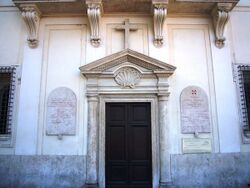
The Italian Methodist Church (Italian: Chiesa Metodista Italiana) is a small Protestant community in Italy,[165] with around 7,000 members.[166] Since 1975, it is in a formal covenant of partnership with the Waldensian Church, with a total of 45,000 members.[166] Waldensians are a Protestant movement which started in Lyon, France, in the late 1170s.
Italian Methodism has its origins in the Italian Free Church, British Wesleyan Methodist Missionary Society, and the American Methodist Episcopal Mission. These movements flowered in the second half of the 19th century in the new climate of political and religious freedom that was established with the end of the Papal States and unification of Italy in 1870.[143]
Bertrand M. Tipple, minister of the American Methodist Church in Rome, founded a college there in 1914.[167]
In April 2016, the World Methodist Council opened an Ecumenical Office in Rome. Methodist leaders and the leader of the Roman Catholic Church, Pope Francis, jointly dedicated the new office.[168] It helps facilitate Methodist relationships with the wider Church, especially the Roman Catholic Church.[169]
Nordic and Baltic countries
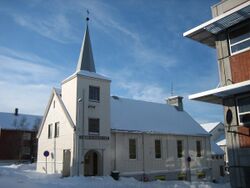
The "Nordic and Baltic Area" of the United Methodist Church covers the Nordic countries (Denmark, Sweden, Norway, and Finland) and the Baltic countries (Estonia, Latvia, and Lithuania). Methodism was introduced to the Nordic countries in the late 19th century.[170] Today the United Methodist Church in Norway (Norwegian: Metodistkirken) is the largest annual meeting in the region with 10,684 members in total ((As of 2013)).[145] The United Methodist Church in Sweden (Swedish: Metodistkyrkan) joined the Uniting Church in Sweden in 2011.[171]
In Finland, Methodism arrived through Ostrobothnians sailors in the 1860s, and Methodism spread especially in Swedish-speaking Ostrobothnia. The first Methodist congregation was founded in Vaasa in 1881 and the first Finnish-speaking congregation in Pori in 1887.[172] At the turn of the century, the congregation in Vaasa became the largest and most active congregation in Methodism.[173]
France
The French Methodist movement was founded in the 1820s by Charles Cook in the village of Congénies in Languedoc near Nîmes and Montpellier. The most important chapel of department was built in 1869, where there had been a Quaker community since the 18th century.[174] Sixteen Methodist congregations voted to join the Reformed Church of France in 1938.[175] In the 1980s, missionary work of a Methodist church in Agen led to new initiatives in Fleurance and Mont de Marsan.[176]
Methodism exists today in France under various names. The best-known is the Union of Evangelical Methodist Churches (French: l'Union de l'Eglise Evangélique Méthodiste) or UEEM. It is an autonomous regional conference of the United Methodist Church and is the fruit of a fusion in 2005 between the "Methodist Church of France" and the "Union of Methodist Churches". (As of 2014), the UEEM has around 1,200 members and 30 ministers.[175]
Germany
In Germany, Switzerland and Austria, Evangelisch-methodistische Kirche is the name of the United Methodist Church. The German part of the church had about 52,031 members (As of 2015).[146] Members are organized into three annual conferences: north, east and south.[146] All three annual conferences belong to the Germany Central Conference.[177] Methodism is most prevalent in southern Saxony and around Stuttgart.[citation needed]
A Methodist missionary returning from Britain introduced (British) Methodism to Germany in 1830, initially in the region of Württemberg. Methodism was also spread in Germany through the missionary work of the Methodist Episcopal Church which began in 1849 in Bremen, soon spreading to Saxony and other parts of Germany. Other Methodist missionaries of the Evangelical Association went near Stuttgart (Württemberg) in 1850.[177] Further Methodist missionaries of the Church of the United Brethren in Christ worked in Franconia and other parts of Germany from 1869 until 1905.[178] Therefore, Methodism has four roots in Germany.
Early opposition towards Methodism was partly rooted in theological differences – northern and eastern regions of Germany were predominantly Lutheran and Reformed, and Methodists were dismissed as fanatics. Methodism was also hindered by its unfamiliar church structure (Connectionalism), which was more centralised than the hierarchical polity in the Lutheran and Reformed churches. After World War I, the 1919 Weimar Constitution allowed Methodists to worship freely and many new chapels were established. In 1936, German Methodists elected their first bishop.[179]
Hungary
The first Methodist mission in Hungary was established in 1898 in Bácska, in a then mostly German-speaking town of Verbász (since 1918 part of the Serbian province of Vojvodina).[citation needed] In 1905 a Methodist mission was established also in Budapest. In 1974, a group later known as the Hungarian Evangelical Fellowship seceded from the Hungarian Methodist Church over the question of interference by the communist state.
(As of 2017), the United Methodist Church in Hungary, known locally as the Hungarian Methodist Church (Hungarian: Magyarországi Metodista Egyház), had 453 professing members in 30 congregations.[180] It runs two student homes, two homes for the elderly, the Forray Methodist High School, the Wesley Scouts and the Methodist Library and Archives.[181] The church has a special ministry among the Roma.[182][183]
The seceding Hungarian Evangelical Fellowship (Magyarországi Evangéliumi Testvérközösség) also remains Methodist in its organisation and theology. It has eight full congregations and several mission groups, and runs a range of charitable organisations: hostels and soup kitchens for the homeless, a non-denominational theological college,[184] a dozen schools of various kinds, and four old people's homes.
Today there are a dozen Methodist/Wesleyan churches and mission organisations in Hungary, but all Methodist churches lost official church status under new legislation passed in 2011, when the number of officially recognized churches in the country fell to 14.[185] However, the list of recognized churches was lengthened to 32 at the end of February 2012.[186] This gave recognition to the Hungarian Methodist Church and the Salvation Army, which was banned in Hungary in 1949 but had returned in 1990, but not to the Hungarian Evangelical Fellowship. The legislation has been strongly criticised by the Venice Commission of the Council of Europe as discriminatory.[187]
The Hungarian Methodist Church, the Salvation Army and the Church of the Nazarene and other Wesleyan groups formed the Wesley Theological Alliance for theological and publishing purposes in 1998.[188] Today the Alliance has 10 Wesleyan member churches and organisations. The Hungarian Evangelical Fellowship does not belong to it and has its own publishing arm.[189]
Russia
The Methodist Church established several strongholds in Russia – Saint Petersburg in the west and the Vladivostok region in the east, with large Methodist centres in Moscow and Ekaterinburg (former Sverdlovsk). Methodists began their work in the west among Swedish immigrants in 1881 and started their work in the east in 1910.[190] On 26 June 2009, Methodists celebrated the 120th year since Methodism arrived in Czarist Russia by erecting a new Methodist centre in Saint Petersburg.[190] A Methodist presence was continued in Russia for 14 years after the Russian Revolution of 1917 through the efforts of Deaconess Anna Eklund.[191] In 1939, political antagonism stymied the work of the Church and Deaconess Anna Eklund was coerced to return to her native Finland.[190]
After 1989, the Soviet Union allowed greatly increased religious freedoms[192] and this continued after the USSR's collapse in 1991. During the 1990s, Methodism experienced a powerful wave of revival in the nation.[190] Three sites in particular carried the torch – Samara, Moscow and Ekaterinburg. (As of 2011), the United Methodist Church in Eurasia comprised 116 congregations, each with a native pastor. There are currently 48 students enrolled in residential and extension degree programs at the United Methodist Seminary in Moscow.[190]
Caribbean
Methodism came to the Caribbean in 1760 when the planter, lawyer and Speaker of the Antiguan House of Assembly, Nathaniel Gilbert (c. 1719–1774), returned to his sugar estate home in Antigua.[193] A Methodist revival spread in the British West Indies due to the work of British missionaries.[194] Missionaries established societies which would later become the Methodist Church in the Caribbean and the Americas (MCCA). The MCCA has about 62,000 members in over 700 congregations, ministered by 168 pastors.[194] There are smaller Methodist denominations that have seceded from the parent church.[citation needed]
Antigua
The story is often told that in 1755, Nathaniel Gilbert, while convalescing, read a treatise of John Wesley, An Appeal to Men of Reason and Religion sent to him by his brother Francis. As a result of having read this book Gilbert, two years later, journeyed to England with three of his slaves and there in a drawing room meeting arranged in Wandsworth on 15 January 1759, met the preacher John Wesley. He returned to the Caribbean that same year and on his subsequent return began to preach to his slaves in Antigua.[193]
When Gilbert died in 1774 his work in Antigua was continued by his brother Francis Gilbert to approximately 200 Methodists. However, within a year Francis took ill and returned to Britain and the work was carried on by Sophia Campbell ("a Negress") and Mary Alley ("a Mulatto"), two devoted women who kept the flock together with class and prayer meetings as best as they could.[194]
On 2 April 1778, John Baxter, a local preacher and skilled shipwright from Chatham in Kent, England, landed at English Harbour in Antigua (now called Nelson's Dockyard) where he was offered a post at the naval dockyard. Baxter was a Methodist and had heard of the work of the Gilberts and their need for a new preacher. He began preaching and meeting with the Methodist leaders, and within a year the Methodist community had grown to 600 persons. By 1783, the first Methodist chapel was built in Antigua, with John Baxter as the local preacher, its wooden structure seating some 2,000 people.[195]
St. Bart's
In 1785, William Turton (1761–1817) a Barbadian son of a planter, met John Baxter in Antigua, and later, as layman, assisted in the Methodist work in the Swedish colony of St. Bartholomew from 1796.[193]
In 1786, the missionary endeavour in the Caribbean was officially recognized by the Methodist Conference in England, and that same year Thomas Coke, having been made Superintendent of the church two years previously in America by Wesley, was travelling to Nova Scotia, but weather forced his ship to Antigua.[citation needed]
Jamaica
In 1818 Edward Fraser (1798 – aft. 1850), a privileged Barbadian slave, moved to Bermuda and subsequently met the new minister James Dunbar. The Nova Scotia Methodist Minister noted young Fraser's sincerity and commitment to his congregation and encouraged him by appointing him as assistant. By 1827 Fraser assisted in building a new chapel. He was later freed and admitted to the Methodist Ministry to serve in Antigua and Jamaica.[193]
Barbados
Following William J. Shrewsbury's preaching in the 1820s, Sarah Ann Gill (1779–1866), a free-born black woman, used civil disobedience in an attempt to thwart magistrate rulings that prevented parishioners holding prayer meetings. In hopes of building a new chapel, she paid an extraordinary £1,700-0s–0d and ended up having militia appointed by the Governor to protect her home from demolition.[196]
In 1884 an attempt was made at autonomy with the formation of two West Indian Conferences, however by 1903 the venture had failed. It was not until the 1960s that another attempt was made at autonomy. This second attempt resulted in the emergence of the Methodist Church in the Caribbean and the Americas in May 1967.[194]
Francis Godson (1864–1953), a Methodist minister, who having served briefly in several of the Caribbean islands, eventually immersed himself in helping those in hardship of the First World War in Barbados. He was later appointed to the Legislative Council of Barbados, and fought for the rights of pensioners. He was later followed by renowned Barbadian Augustus Rawle Parkinson (1864–1932),[197] who also was the first principal of the Wesley Hall School, Bridgetown in Barbados (which celebrated its 125th anniversary in September 2009).[193]
In more recent times in Barbados, Victor Alphonso Cooke (born 1930) and Lawrence Vernon Harcourt Lewis (born 1932) are strong influences on the Methodist Church on the island.[193] Their contemporary and late member of the Dalkeith Methodist Church, was the former secretary of the University of the West Indies, consultant of the Canadian Training Aid Programme and a man of letters – Francis Woodbine Blackman (1922–2010). It was his research and published works that enlightened much of this information on Caribbean Methodism.[198][199]
Africa
Most Methodist denominations in Africa follow the British Methodist tradition and see the Methodist Church of Great Britain as their mother church. Originally modelled on the British structure, since independence most of these churches have adopted an episcopal model of church governance.
Nigeria
The Nigerian Methodist Church is one of the largest Methodist denominations in the world and one of the largest Christian churches in Nigeria, with around two million members in 2000 congregations.[200] It has seen exponential growth since the turn of the millennium.[201]
Christianity was established in Nigeria with the arrival in 1842 of a Wesleyan Methodist missionary.[200] He had come in response to the request for missionaries by the ex-slaves who returned to Nigeria from Sierra Leone. From the mission stations established in Badagry and Abeokuta, the Methodist church spread to various parts of the country west of the River Niger and part of the north. In 1893 missionaries of the Primitive Methodist Church arrived from Fernando Po, an island off the southern coast of Nigeria. From there the Methodist Church spread to other parts of the country, east of the River Niger and also to parts of the north. The church west of the River Niger and part of the north was known as the Western Nigeria District and east of the Niger and another part of the north as the Eastern Nigeria District. Both existed independently of each other until 1962 when they constituted the Conference of Methodist Church Nigeria. The conference is composed of seven districts. The church has continued to spread into new areas and has established a department for evangelism and appointed a director of evangelism. An episcopal system of church governance adopted in 1976 was not fully accepted by all sections of the church until the two sides came together and resolved to end the disagreement. A new constitution was ratified in 1990. The system is still episcopal but the points which caused discontent were amended to be acceptable to both sides. Today, the Nigerian Methodist Church has a prelate, eight archbishops and 44 bishops.[200]
Ghana
Methodist Church Ghana is one of the largest Methodist denominations, with around 800,000 members in 2,905 congregations, ministered by 700 pastors.[202] It has fraternal links with the British Methodist and United Methodist churches worldwide.
Methodism in Ghana came into existence as a result of the missionary activities of the Wesleyan Methodist Church, inaugurated with the arrival of Joseph Rhodes Dunwell to the Gold Coast in 1835.[203] Like the mother church, the Methodist Church in Ghana was established by people of Protestant background. Roman Catholic and Anglican missionaries came to the Gold Coast from the 15th century. A school was established in Cape Coast by the Anglicans during the time of Philip Quaque, a Ghanaian priest. Those who came out of this school had Bible copies and study supplied by the Society for the Propagation of Christian Knowledge. A member of the resulting Bible study groups, William De-Graft, requested Bibles through Captain Potter of the ship Congo. Not only were Bibles sent, but also a Methodist missionary. In the first eight years of the Church's life, 11 out of 21 missionaries who worked in the Gold Coast died. Thomas Birch Freeman, who arrived at the Gold Coast in 1838 was a pioneer of missionary expansion. Between 1838 and 1857 he carried Methodism from the coastal areas to Kumasi in the Asante hinterland of the Gold Coast. He also established Methodist Societies in Badagry and AbeoKuta in Nigeria with the assistance of William De-Graft.[citation needed]
By 1854, the church was organized into circuits constituting a district with T. B. Freeman as chairman. Freeman was replaced in 1856 by William West. The district was divided and extended to include areas in the then Gold Coast and Nigeria by the synod in 1878, a move confirmed at the British Conference. The districts were Gold Coast District, with T. R. Picot as chairman and Yoruba and Popo District, with John Milum as chairman. Methodist evangelisation of northern Gold Coast began in 1910. After a long period of conflict with the colonial government, missionary work was established in 1955. Paul Adu was the first indigenous missionary to northern Gold Coast.[citation needed]
In July 1961, the Methodist Church in Ghana became autonomous, and was called the Methodist Church Ghana, based on a deed of foundation, part of the church's Constitution and Standing Orders.[202]
Southern Africa
The Methodist Church operates across South Africa, Namibia, Botswana, Lesotho and Swaziland, with a limited presence in Zimbabwe and Mozambique. It is a member church of the World Methodist Council.
Methodism in Southern Africa began as a result of lay Christian work by an Irish soldier of the English Regiment, John Irwin, who was stationed at the Cape and began to hold prayer meetings as early as 1795.[204] The first Methodist lay preacher at the Cape, George Middlemiss, was a soldier of the 72nd Regiment of the British Army stationed at the Cape in 1805.[205] This foundation paved the way for missionary work by Methodist missionary societies from Great Britain, many of whom sent missionaries with the 1820 English settlers to the Western and Eastern Cape. Among the most notable of the early missionaries were Barnabas Shaw and William Shaw.[206][207][208] The largest group was the Wesleyan Methodist Church, but there were a number of others that joined to form the Methodist Church of South Africa, later known as the Methodist Church of Southern Africa.[209]
The Methodist Church of Southern Africa is the largest mainline Protestant denomination in South Africa – 7.3% of the South African population recorded their religious affiliation as 'Methodist' in the last national census.[210]
Asia
China

Methodism was brought to China in the autumn of 1847 by the Methodist Episcopal Church. The first missionaries sent out were Judson Dwight Collins and Moses Clark White, who sailed from Boston 15 April 1847, and reached Fuzhou 6 September. They were followed by Henry Hickok and Robert Samuel Maclay, who arrived 15 April 1848. In 1857, the first convert was baptised in connection with its labours. In August 1856, a brick built church was dedicated named the "Church of the True God" (Chinese: 真神堂; pinyin: Zhēnshén táng), the first substantial church building erected in Fuzhou by Protestant Missions. In the winter of the same year another brick built church, located on the hill in the suburbs on the south bank of the Min, was finished and dedicated, called the "Church of Heavenly Peace". In 1862, the number of members was 87. The Fuzhou Conference was organized by Isaac W. Wiley on 6 December 1867, by which time the number of members and probationers had reached 2,011.[citation needed]
Hok Chau (周學; Zhōu Xué; also known as Lai-Tong Chau, 周勵堂; Zhōu Lìtáng) was the first ordained Chinese minister of the South China District of the Methodist Church (incumbent 1877–1916). Benjamin Hobson, a medical missionary sent by the London Missionary Society in 1839, set up Wai Ai Clinic (惠愛醫館; Huì ài yī guǎn).[211][212] Liang Fa, Hok Chau and others worked there. Liang baptized Chau in 1852. The Methodist Church based in Britain sent missionary George Piercy to China. In 1851, Piercy went to Guangzhou (Canton), where he worked in a trading company. In 1853, he started a church in Guangzhou. In 1877, Chau was ordained by the Methodist Church, where he pastored for 39 years.[213][214]
In 1867, the mission sent out the first missionaries to Central China, who began work at Jiujiang. In 1869, missionaries were also sent to the capital city Beijing, where they laid the foundations of the work of the North China Mission. In November 1880, the West China Mission was established in Sichuan Province. In 1896, the work in the Hinghua prefecture (modern-day Putian) and surrounding regions was also organized as a Mission Conference.[215]
In 1947, the Methodist Church in the Republic of China celebrated its centenary. In 1949, however, the Methodist Church moved to Taiwan with the Kuomintang government.
Hong Kong
India
Methodism came to India twice, in 1817 and in 1856, according to P. Dayanandan who has extensively researched the subject.[216] Thomas Coke and six other missionaries set sail for India on New Year's Day in 1814. Coke, then 66, died en route. Rev. James Lynch was the one who finally arrived in Madras in 1817 at a place called Black Town (Broadway), later known as George Town. Lynch conducted the first Methodist missionary service on 2 March 1817, in a stable.[citation needed]
The first Methodist church was dedicated in 1819 at Royapettah. A chapel at Broadway (Black Town) was later built and dedicated on 25 April 1822.[217] This church was rebuilt in 1844 since the earlier structure was collapsing.[217] At this time there were about 100 Methodist members in all of Madras, and they were either Europeans or Eurasians (European and Indian descent). Among names associated with the founding period of Methodism in India are Elijah Hoole and Thomas Cryer, who came as missionaries to Madras.[218]
In 1857, the Methodist Episcopal Church started its work in India, and with prominent evangelists like William Taylor of the Emmanuel Methodist Church, Vepery, born in 1874. The evangelist James Mills Thoburn established the Thoburn Memorial Church in Calcutta in 1873 and the Calcutta Boys' School in 1877.[citation needed]
In 1947, the Wesleyan Methodist Church in India merged with Presbyterians, Anglicans and other Protestant churches to form the Church of South India while the American Methodist Church remained affiliated as the Methodist Church in Southern Asia (MCSA) to the mother church in the USA – the United Methodist Church until 1981, when by an enabling act, the Methodist Church in India (MCI) became an autonomous church in India. Today, the Methodist Church in India is governed by the General Conference of the Methodist Church of India headed by six bishops, with headquarters in Mumbai, India.[219]
Malaysia and Singapore
Missionaries from Britain, North America, and Australia founded Methodist churches in many Commonwealth countries. These are now independent from their former "mother" churches. In addition to the churches, these missionaries often also founded schools to serve the local community. A good example of such schools are the Methodist Boys' School in Kuala Lumpur, Methodist Girls' School and Methodist Boys' School in George Town, and Anglo-Chinese School, Methodist Girls' School, Paya Lebar Methodist Girls School and Fairfield Methodist Schools in Singapore.[220]
Philippines
Methodism in the Philippines began shortly after the United States acquired the Philippines in 1898 as a result the Spanish–American War. On 21 June 1898, after the Battle of Manila Bay but before the Treaty of Paris, executives of the American Mission Society of the Methodist Episcopal Church expressed their desire to join other Protestant denominations in starting mission work in the islands and to enter into a Comity Agreement that would facilitate the establishment of such missions. The first Protestant worship service was conducted on 28 August 1898 by an American military chaplain named George C. Stull. Stull was an ordained Methodist minister from the Montana Annual Conference of The Methodist Episcopal Church (later part of the United Methodist Church after 1968).[221]
Methodist and Wesleyan traditions in the Philippines are shared by three of the largest mainline Protestant churches in the country: The United Methodist Church in the Philippines, Iglesia Evangelica Metodista En Las Islas Filipinas ("Evangelical Methodist Church in the Philippine Islands", abbreviated IEMELIF), and The United Church of Christ in the Philippines.[222] There are also evangelical Protestant churches in the country of the Methodist tradition like the Wesleyan Church of the Philippines, the Free Methodist Church of the Philippines,[223] and the Church of the Nazarene.[224] There are also the IEMELIF Reform Movement (IRM), The Wesleyan (Pilgrim Holiness) Church of the Philippines, the Philippine Bible Methodist Church, Incorpoorated, the Pentecostal Free Methodist Church, Incorporated, the Fundamental Christian Methodist Church, The Reformed Methodist Church, Incorporated, The Methodist Church of the Living Bread, Incorporated, and the Wesley Evangelical Methodist Church & Mission, Incorporated.
There are three episcopal areas of the United Methodist Church in the Philippines: the Baguio Episcopal Area, Davao Episcopal Area and Manila Episcopal Area.[225]
A call for autonomy from groups within the United Methodist Church in the Philippines was discussed at several conferences led mostly by episcopal candidates. This led to the establishment of the Ang Iglesia Metodista sa Pilipinas ("The Methodist Church in the Philippines") in 2010,[226] led by Bishop Lito C. Tangonan, George Buenaventura, Chita Milan and Atty. Joe Frank E. Zuñiga. The group finally declared full autonomy and legal incorporation with the Securities and Exchange Commission was approved on 7 December 2011 with papers held by present procurators. It now has 126 local churches in Metro Manila, Palawan, Bataan, Zambales, Pangasinan, Bulacan,[227] Aurora, Nueva Ecija, as well as parts of Pampanga and Cavite. Tangonan was consecrated as the denomination's first Presiding Bishop on 17 March 2012.[228]
South Korea
The Korean Methodist Church (KMC) is one of the largest churches in South Korea with around 1.5 million members and 8,306 ministers.[229] Methodism in Korea grew out of British and American mission work which began in the late 19th century. The first missionary was Robert Samuel Maclay of the Methodist Episcopal Church, who sailed from Japan in 1884 and was given the authority of medical and schooling permission from emperor Gojong.[230] The Korean church became fully autonomous in 1930, retaining affiliation with Methodist churches in America and later the United Methodist Church.[229] The church experienced rapid growth in membership throughout most of the 20th century – in spite of the Korean War – before stabilizing in the 1990s.[229] The KMC is a member of the World Methodist Council and hosted the first Asia Methodist Convention in 2001.[229]
There are many Korean-language Methodist churches in North America catering to Korean-speaking immigrants, not all of which are named as Methodist.
Taiwan
In 1947, the Methodist Church in the Republic of China celebrated its centenary. In 1949, however, the Methodist Church moved to Taiwan with the Kuomintang government. On 21 June 1953, Taipei Methodist Church was erected, then local churches and chapels with a baptized membership numbering over 2,500. Various types of educational, medical and social services are provided (including Tunghai University). In 1972, the Methodist Church in the Republic of China became autonomous, and the first bishop was installed in 1986.[231]
Americas
Brazil
The Methodist Church in Brazil was founded by American missionaries in 1867 after an initial unsuccessful founding in 1835. It has grown steadily since, becoming autonomous in 1930. In the 1970s it ordained its first woman minister. In 1975 it also founded the first Methodist university in Latin America, the Methodist University of Piracicaba.[232] (As of 2011), the Brazilian Methodist Church is divided into eight annual conferences with 162,000 members.[233]
Canada
The father of Methodism in Canada was Rev. Coughlan, who arrived in Newfoundland in 1763, where he opened a school and travelled widely.
The second was William Black (1760–1834) who began preaching in settlements along the Petitcodiac River of New Brunswick in 1781.[234] A few years afterwards, Methodist Episcopal circuit riders from the U.S. state of New York began to arrive in Canada West at Niagara, and the north shore of Lake Erie in 1786, and at the Kingston region on the northeast shore of Lake Ontario in the early 1790s. At the time the region was part of British North America and became part of Upper Canada after the Constitutional Act of 1791. Upper and Lower Canada were both parts of the New York Episcopal Methodist Conference until 1810 when they were transferred to the newly formed Genesee Conference. Reverend Major George Neal began to preach in Niagara in October 1786 and was ordained in 1810 by Bishop Philip Asbury, at the Lyons, New York Methodist Conference. He was Canada's first saddlebag preacher and travelled from Lake Ontario to Detroit for 50 years preaching the gospel.[citation needed]
The spread of Methodism in the Canadas was seriously disrupted by the War of 1812 but quickly gained lost ground after the Treaty of Ghent was signed in 1815. In 1817, the British Wesleyans arrived in the Canadas from the Maritimes but by 1820 had agreed, with the Episcopal Methodists, to confine their work to Lower Canada (present-day Quebec) while the latter would confine themselves to Upper Canada (present-day Ontario). In the summer of 1818, the first place of public worship was erected for the Wesleyan Methodists in York, later Toronto. The chapel for the First Methodist Church was built on the corner of King Street and Jordan Street, the entire cost of the building was $250, an amount that took the congregation three years to raise.[235] In 1828, Upper Canadian Methodists were permitted by the General Conference in the United States to form an independent Canadian Conference and, in 1833, the Canadian Conference merged with the British Wesleyans to form the Wesleyan Methodist Church in Canada. In 1884, most Canadian Methodists were brought under the umbrella of the Methodist Church, Canada.[citation needed]
In 1925, the Methodist Church, Canada and most Presbyterian congregations (then by far the largest Protestant communion in Canada), most Congregational Union of Ontario and Quebec congregations, Union Churches in Western Canada, and the American Presbyterian Church in Montreal merged to form the United Church of Canada. In 1968, the Evangelical United Brethren Church's Canadian congregations joined after their American counterparts joined the United Methodist Church.[citation needed]
Mexico
The Methodist Church came to Mexico in 1872, with the arrival of two Methodist commissioners from the United States to observe the possibilities of evangelistic work in México. In December 1872, Bishop Gilbert Haven arrived in Mexico City. He was ordered by M. D. William Butler to go to México. Bishop John C. Keener arrived from the Methodist Episcopal Church, South in January 1873.[236][237]
In 1874, M. D. William Butler established the first Protestant Methodist school of México, in Puebla. The school was founded under the name "Instituto Metodista Mexicano". Today the school is called "Instituto Mexicano Madero". It is still a Methodist school, and it is one of the most elite, selective, expensive and prestigious private schools in the country,[238] with two campuses in Puebla State, and one in Oaxaca. A few years later the principal of the school created a Methodist university.[239]
On 18 January 1885, the first Annual Conference of the United Episcopal Church of México was established.[240]
United States
Wesley came to believe that the New Testament evidence did not leave the power of ordination to the priesthood in the hands of bishops but that other priests could ordain. In 1784, he ordained preachers for Scotland, England, and America, with power to administer the sacraments (this was a major reason for Methodism's final split from the Church of England after Wesley's death). At that time, Wesley sent Thomas Coke to America. Francis Asbury founded the Methodist Episcopal Church at the Baltimore Christmas Conference in 1784; Coke (already ordained in the Church of England) ordained Asbury deacon, elder, and bishop each on three successive days.[241] Circuit riders, many of whom were laymen, travelled by horseback to preach the gospel and establish churches in many places. One of the most famous circuit riders was Robert Strawbridge who lived in the vicinity of Carroll County, Maryland, soon after arriving in the Colonies around 1760.[citation needed]
The First Great Awakening was a religious movement in the 1730s and 1740s, beginning in New Jersey, then spreading to New England, and eventually south into Virginia and North Carolina. George Whitefield played a major role, traveling across the colonies and preaching in a dramatic and emotional style, accepting everyone as his audience.[242]
The new style of sermons and the way people practiced their faith breathed new life into religion in America. People became passionately and emotionally involved in their religion, rather than passively listening to intellectual discourse in a detached manner. People began to study the Bible at home. The effect was akin to the individualistic trends present in Europe during the Protestant Reformation.[citation needed]

The Second Great Awakening was a nationwide wave of revivals, from 1790 to 1840. In New England, the renewed interest in religion inspired a wave of social activism among Yankees; Methodism grew and established several colleges, notably Boston University. In the "burned over district" of western New York, the spirit of revival burned brightly. Methodism saw the emergence of a Holiness movement. In the west, especially at Cane Ridge, Kentucky, and in Tennessee , the revival strengthened the Methodists and the Baptists. Methodism grew rapidly in the Second Great Awakening, becoming the nation's largest denomination by 1820. From 58,000 members in 1790, it reached 258,000 in 1820 and 1,661,000 in 1860, growing by a factor of 28.6 in 70 years, while the total American population grew by a factor of eight.[244] Other denominations also used revivals, but the Methodists grew fastest of all because "they combined popular appeal with efficient organization under the command of missionary bishops."[245] Methodism attracted German immigrants, and the first German Methodist Church was erected in Cincinnati, Ohio.[246]
Disputes over slavery placed the church in difficulty in the first half of the 19th century, with the northern church leaders fearful of a split with the South, and reluctant to take a stand. The Wesleyan Methodist Connexion (later renamed the Wesleyan Methodist Church) and the Free Methodist Church were formed by staunch abolitionists, and the Free Methodists were especially active in the Underground Railroad, which helped to free slaves. In 1962, the Evangelical Wesleyan Church separated from the Free Methodist Church.[247] In 1968 the Wesleyan Methodist Church and Pilgrim Holiness Church merged to form the Wesleyan Church; a significant amount dissented from this decision resulting in the independence of the Allegheny Wesleyan Methodist Connection and the formation of the Bible Methodist Connection of Churches, both of which fall within the conservative holiness movement.[248]
In a much larger split, in 1845 at Louisville, Kentucky, the churches of the slaveholding states left the Methodist Episcopal Church and formed The Methodist Episcopal Church, South. The northern and southern branches were reunited in 1939, when slavery was no longer an issue. In this merger also joined the Methodist Protestant Church. Some southerners, more conservative in theology, opposed the merger, and formed the Southern Methodist Church in 1940.
The Third Great Awakening from 1858 to 1908 saw enormous growth in Methodist membership, and a proliferation of institutions such as colleges (e.g., Morningside College). Methodists were often involved in the Missionary Awakening and the Social Gospel Movement. The awakening in so many cities in 1858 started the movement, but in the North it was interrupted by the Civil War. In the South, on the other hand, the Civil War stimulated revivals, especially in Lee's army.[249]
In 1914–1917 many Methodist ministers made strong pleas for world peace. President Woodrow Wilson (a Presbyterian), promised "a war to end all wars," using language of a future peace that had been a watchword for the postmillennial movement.[250] In the 1930s many Methodists favored isolationist policies. Thus in 1936, Methodist Bishop James Baker, of the San Francisco Conference, released a poll of ministers showing 56% opposed warfare. However, the Methodist Federation called for a boycott of Japan, which had invaded China and was disrupting missionary activity there.[251] In Chicago, 62 local African Methodist Episcopal churches voted their support for the Roosevelt administration's policy, while opposing any plan to send American troops overseas to fight. When war came in 1941, the vast majority of Methodists supported the national war effort, but there were also a few (673)[252] conscientious objectors.
The United Methodist Church (UMC) was formed in 1968 as a result of a merger between the Evangelical United Brethren Church (EUB) and The Methodist Church. The former church had resulted from mergers of several groups of German Methodist heritage; however, there was no longer any need or desire to worship in the German language. The latter church was a result of union between the Methodist Protestant Church and the northern and southern factions of the Methodist Episcopal Church. The merged church had approximately nine million members as of the late 1990s. While United Methodist Church in America membership has been declining, associated groups in developing countries are growing rapidly.[253] Prior to the merger that led to the formation of the United Methodist Church, the Evangelical Methodist Church entered into a schism with the Methodist Church, citing modernism in its parent body as the reason for the departure in 1946.[254]
American Methodist churches are generally organized on a connectional model, related, but not identical to that used in Britain. Pastors are assigned to congregations by bishops, distinguishing it from presbyterian government. Methodist denominations typically give lay members representation at regional and national Conferences at which the business of the church is conducted, making it different from most episcopal government. This connectional organizational model differs further from the congregational model, for example of Baptist, and Congregationalist Churches, among others.[citation needed]
In addition to the United Methodist Church, there are over 40 other denominations that descend from John Wesley's Methodist movement. Some, such as the African Methodist Episcopal Church, the Free Methodists and the Wesleyan Church (formerly Wesleyan Methodist), are explicitly Methodist. There are also independent Methodist churches, many of which are affiliated with the Association of Independent Methodists.[255] The Salvation Army and the Church of the Nazarene adhere to Methodist theology.[256]
The Holiness Revival was primarily among people of Methodist persuasion, who felt that the church had once again become apathetic, losing the Wesleyan zeal.[257] Some important events of this revival were the writings of Phoebe Palmer during the mid-1800s,[258] the establishment of the first of many holiness camp meetings at Vineland, New Jersey in 1867, and the founding of Asbury College, (1890), and other similar institutions in the U.S. around the turn of the 20th century.
In 2020, United Methodists announced a plan to split the denomination over the issue of same-sex marriage,[259] which resulted in traditionalist clergy, laity and theologians forming the Global Methodist Church, a traditionalist Methodist denomination that came into being on 1 May 2022.[260][261][262]
Oceania
Methodism is particularly widespread in some Pacific Island nations, such as Fiji, Samoa and Tonga.
Australia
In the 19th century there were annual conferences in each Australasian colony (including New Zealand). Various branches of Methodism in Australia merged during the 20 years from 1881. The Methodist Church of Australasia was formed on 1 January 1902 when five Methodist denominations in Australia – the Wesleyan Methodist Church, the Primitive Methodists, the Bible Christian Church, the United Methodist Free and the Methodist New Connexion Churches merged.[263][264] In polity it largely followed the Wesleyan Methodist Church.
In 1945 Kingsley Ridgway offered himself as a Melbourne-based "field representative" for a possible Australian branch of the Wesleyan Methodist Church of America, after meeting an American serviceman who was a member of that denomination.[265] The Wesleyan Methodist Church of Australia was founded on his work.
The Methodist Church of Australasia merged with the majority of the Presbyterian Church of Australia and the Congregational Union of Australia in 1977, becoming the Uniting Church. The Wesleyan Methodist Church of Australia and some independent congregations chose not to join the union.[266]
Wesley Mission in Pitt Street, Sydney, the largest parish in the Uniting Church, remains strongly in the Wesleyan tradition.[267] There are many local churches named after John Wesley.
From the mid-1980s a number of independent Methodist churches were founded by missionaries and other members from the Methodist Churches of Malaysia and Singapore. Some of these came together to form what is now known as the Chinese Methodist Church in Australia in 1993, and it held its first full Annual Conference in 2002.[268] Since the 2000s many independent Methodist churches have also been established or grown by Tongan immigrants.[269]
Fiji
As a result of the early efforts of missionaries, most of the natives of the Fiji Islands were converted to Methodism in the 1840s and 1850s.[270] According to the 2007 census, 34.6% of the population (including almost two-thirds of ethnic Fijians),[271] are adherents of Methodism, making Fiji one of the most Methodist nations. The Methodist Church of Fiji and Rotuma, the largest religious denomination, is an important social force along with the traditional chiefly system. In the past, the church once called for a theocracy and fueled anti-Hindu sentiment.[272]
New Zealand
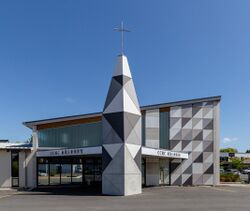
In June 1823 Wesleydale, the first Wesleyan Methodist mission in New Zealand, was established at Kaeo.[273] The Methodist Church of New Zealand, which is directly descended from the 19th-century missionaries, was the fourth-most common Christian denomination recorded in the 2018 New Zealand census.[274]
Since the early 1990s, missionaries and other Methodists from Malaysia and Singapore established Methodist churches around major urban areas in New Zealand. These congregations came together to form the Chinese Methodist Church in New Zealand (CMCNZ) in 2003.[citation needed]
Samoan Islands
The Methodist Church is the third largest denomination throughout the Samoan Islands, in both Samoa and American Samoa.[275] In 1868, Piula Theological College was established in Lufilufi on the north coast of Upolu island in Samoa and serves as the main headquarters of the Methodist church in the country.[276] The college includes the historic Piula Monastery as well as Piula Cave Pool, a natural spring situated beneath the church by the sea.
Tonga
Methodism had a particular resonance with the inhabitants of Tonga. In the 1830s Wesleyan missionaries converted paramount chief Taufa'ahau Tupou who in turn converted fellow islanders. Today, Methodism is represented on the islands by the Free Church of Tonga and the Free Wesleyan Church, which is the largest church in Tonga. (As of 2011) 48% of Tongans adhered to Methodist churches.[277] The royal family of the country are prominent members of the Free Wesleyan Church, and the late king was a lay preacher.[278][279] Tongan Methodist minister Sione 'Amanaki Havea developed coconut theology, which tailors theology to a Pacific Islands context.[280]
Ecumenical relations
Many Methodists have been involved in the ecumenical movement,[281] which has sought to unite the fractured denominations of Christianity. Because Methodism grew out of the Church of England, a denomination from which neither of the Wesley brothers seceded, some Methodist scholars and historians, such as Rupert E. Davies, have regarded their 'movement' more as a preaching order within wider Christian life than as a church, comparing them with the Franciscans, who formed a religious order within the medieval European church and not a separate denomination.[282] Certainly, Methodists have been deeply involved in early examples of church union, especially the United Church of Canada and the Church of South India.
A disproportionate number of Methodists take part in inter-faith dialogue. For example, Wesley Ariarajah, a long-serving director of the World Council of Churches' sub-unit on "Dialogue with People of Living Faiths and Ideologies" is a Methodist.[283]
In October 1999, an executive committee of the World Methodist Council resolved to explore the possibility of its member churches becoming associated with the doctrinal agreement which had been reached by the Catholic Church and Lutheran World Federation (LWF). In May 2006, the International Methodist–Catholic Dialogue Commission completed its most recent report, entitled "The Grace Given You in Christ: Catholics and Methodists Reflect Further on the Church", and submitted the text to Methodist and Catholic authorities. In July of the same year, in Seoul, South Korea, the Member Churches of the World Methodist Council (WMC) voted to approve and sign a "Methodist Statement of Association" with the Joint Declaration on the Doctrine of Justification, the agreement which was reached and officially accepted in 1999 by the Catholic Church and the Lutheran World Federation and which proclaimed that:
"Together we confess: By grace alone, in faith in Christ's saving work and not because of any merit on our part, we are accepted by God and receive the Holy Spirit, who renews our hearts while equipping and calling us to good works... as sinners our new life is solely due to the forgiving and renewing mercy that God imparts as a gift and that we receive in faith, and never can merit in any way," affirming "fundamental doctrinal agreement" concerning justification between the Catholic Church, the LWF, and the World Methodist Council.[284]
This is not to say there is perfect agreement between the three denominational traditions; while Catholics and Methodists believe that salvation involves cooperation between God and man, Lutherans believe that God brings about the salvation of individuals without any cooperation on their part.
Commenting on the ongoing dialogues with Catholic Church leaders, Ken Howcroft, Methodist minister and the Ecumenical Officer for the Methodist Church of Great Britain, noted that "these conversations have been immensely fruitful."[285] Methodists are increasingly recognizing that the 15 centuries prior to the Reformation constitute a shared history with Catholics, and are gaining new appreciation for neglected aspects of the Catholic tradition.[286] There are, however, important unresolved doctrinal differences separating Roman Catholicism and Methodism, which include "the nature and validity of the ministry of those who preside at the Eucharist [Holy Communion], the precise meaning of the Eucharist as the sacramental 'memorial' of Christ's saving death and resurrection, the particular way in which Christ is present in Holy Communion, and the link between eucharistic communion and ecclesial communion.[287]
In the 1960s, the Methodist Church of Great Britain made ecumenical overtures to the Church of England, aimed at denominational union. Formally, these failed when they were rejected by the Church of England's General Synod in 1972; conversations and co-operation continued, however, leading in 2003 to the signing of a covenant between the two churches.[288] From the 1970s onward, the Methodist Church also started several Local Ecumenical Projects (LEPs, later renamed Local Ecumenical Partnerships) with local neighbouring denominations, which involved sharing churches, schools and in some cases ministers. In many towns and villages Methodists are involved in LEPs which are sometimes with Anglican or Baptist churches, but most commonly Methodist and United Reformed Church. In terms of belief, practice and churchmanship, many Methodists see themselves as closer to the United Reformed Church (another Nonconformist church) than to the Church of England.[citation needed] In the 1990s and early 21st century, the British Methodist Church was involved in the Scottish Church Initiative for Union, seeking greater unity with the established and Presbyterian Church of Scotland, the Scottish Episcopal Church and the United Reformed Church in Scotland.[289]
The Methodist Church of Great Britain is a member of several ecumenical organisations, including the World Council of Churches, the Conference of European Churches, the Community of Protestant Churches in Europe, Churches Together in Britain and Ireland, Churches Together in England, Action of Churches Together in Scotland and Cytûn (Wales).
Methodist denominations in the United States have also strengthened ties with other Christian traditions. In April 2005, bishops in the United Methodist Church approved A Proposal for Interim Eucharistic Sharing. This document was the first step toward full communion with the Evangelical Lutheran Church in America (ELCA). The ELCA approved this same document in August 2005.[290] At the 2008 General Conference, the United Methodist Church approved full communion with the Evangelical Lutheran Church in America.[291] The UMC is also in dialogue with the Episcopal Church for full communion.[292] The two denominations are working on a document called "Confessing Our Faith Together".[needs update]
See also
- List of Methodists
- List of Methodist theologians
- List of Methodist churches
- List of Methodist denominations
- Saints in Methodism
Notes
- ↑ This figure (As of 2013) is an estimate by the World Methodist Council and includes members of united and uniting churches with Methodist participation. It represents approximately 60 million committed members and a further 20 million adherents.
- ↑ 2.0 2.1 Arminianism is named after Jacobus Arminius, a Dutch theologian who was trained to preach Calvinism but concluded that some aspects of Calvinism had to be modified in the light of Scripture.[66] Arminians as well as Calvinists appeal to Scripture and the early Church Fathers to support their respective views, however the differences remain – Arminianism holds to the role of free will in salvation and rejects the doctrines of predestination and unconditional election.[67] John Wesley was perhaps the clearest English proponent of Arminian theology.[68]
- ↑ This social analysis is a summary of a wide variety of books on Methodist history, articles in The Methodist Magazine, etc. Most of the Methodist aristocracy were associated with Selina Hastings, Countess of Huntingdon, who invited Methodist preachers to gatherings which she hosted. Methodists were leaders among Christians at that time in reaching out to the poorest of the working classes. A number of soldiers were also Methodists.[19]
References
- ↑ 1.0 1.1 "Methodist Church". BBC. 12 July 2011. https://www.bbc.co.uk/religion/religions/christianity/subdivisions/methodist_1.shtml.
- ↑ 2.0 2.1 Garrison, Stephen O. (1908) (in English). Probationer's Handbook. Eaton and Mains. pp. 21, 41.
- ↑ American Methodism. S. S. Scranton & Company. 1867. p. 29. https://archive.org/details/americanmethodi00scudgoog. Retrieved 18 October 2007. "But the most-noticeable feature of British Methodism is its missionary spirit, and its organized, effective missionary work. It takes the lead of all other denominations in missionary movements. From its origin, Methodism has been characterized for its zeal in propagandism. It has always been missionary."
- ↑ 4.0 4.1 "Member Churches". World Methodist Council. http://worldmethodistcouncil.org/about/member-churches/.
- ↑ 5.0 5.1 5.2 5.3 Stokes, Mack B. (1998) (in en). Major United Methodist Beliefs. Abingdon Press. p. 95. ISBN 978-0687082124.
- ↑ 6.0 6.1 Abraham, William J.; Kirby, James E. (2009) (in en). The Oxford Handbook of Methodist Studies. Oxford University Press. ISBN 978-0191607431.
- ↑ "Distinctive Emphases of Methodist Belief". https://www.irishmethodist.org/sites/default/files/pdf/news/distinctive_emphases_of_methodist_belief.pdf.
- ↑ 8.0 8.1 Davies, Rupert E.; George, A. Raymond; Rupp, Gordon (2017) (in en). A History of the Methodist Church in Great Britain, Volume Three. Wipf & Stock Publishers. p. 225. ISBN 978-1532630507.
- ↑ Stanglin, Keith D.; McCall, Thomas H. (2012) (in en). Jacob Arminius: Theologian of Grace. Oxford University Press. p. 153. ISBN 978-0199755677.
- ↑ Iovino, Joe (4 September 2018). ""Fishing with a large net": United Methodist camp meetings" (in En-us). The United Methodist Church. https://www.umc.org/en/content/fishing-with-a-large-net-united-methodist-camp-meetings.
- ↑ Tucker, Karen B. Westerfield (2001). American Methodist Worship. Oxford: Oxford University Press. ISBN 978-0198029267.
- ↑ A Collection of Hymns, for the use of the people called Methodists. T. Blanshard. 1820. ISBN 978-0-19-812529-7. https://archive.org/details/acollectionhymn03weslgoog. Retrieved 31 December 2007. "collection of hymns."
- ↑ 13.0 13.1 Wilson, Charles Reagan (2005) (in en). Encyclopedia of Religion in the South. Mercer University Press. ISBN 978-0865547582. "Both Southern Baptist and Methodist organizations engaged in evangelism and social service missions in the United States and abroad. ... However, despite their similarities in evangelism and social services, by the dawn of the 20th century the two denominational women's movements had already diverged from each other because the Methodist organizations had embraced the Social Gospel. They had embarked not only on social service in addition to evangelism but on social reform."
- ↑ "Wesley on Social Holiness". The Methodist Church in Britain. http://www.methodist.org.uk/downloads/wc_Eur_John_Mcmaster_Wesley_on_Social_Holiness.pdf.
- ↑ Abraham, William J.; Kirby, James E. (2009) (in en). The Oxford Handbook of Methodist Studies. Oxford University Press. ISBN 978-0191607431. "First, it is clear that 'evangelism' is primarily concerned with the evangel, the gospel, or the good news we bear in the world."
- ↑ Models for Christian Higher Education: Strategies for Survival and Success in the Twenty-First Century. William B. Eerdmans Publishing Company. 1997. p. 290. ISBN 978-0802841216. https://archive.org/details/modelsforchristi0000unse. Retrieved 18 October 2007. "Wesleyan institutions, whether hospitals, orphanages, soup kitchens or schools, historically were begun with the spirit to serve all people and to transform society."
- ↑ 17.0 17.1 17.2 17.3 17.4 17.5 17.6 17.7 17.8 Scott, David W. (2016) (in English). Mission as Globalization: Methodists in Southeast Asia at the Turn of the Twentieth Century. Lexington Books. p. 65. ISBN 978-1-4985-2664-7.
- ↑ 18.0 18.1 McKnight, Scot (2010) (in English). Fasting: The Ancient Practices. Thomas Nelson. pp. 88. ISBN 978-1418576134. "John Wesley, in his Journal, wrote on Friday, August 17, 1739, that "many of our society met, as we had appointed, at one in the afternoon and agreed that all members of our society should obey the Church to which we belong by observing 'all Fridays in the year' as 'days of fasting and abstinence.'"
- ↑ J A Clapperton, "Romance and Heroism in Early Methodism", (1901)
- ↑ Swatos, William H. (1998) (in en). Encyclopedia of Religion and Society. Rowman Altamira. p. 385. ISBN 978-0761989561.
- ↑ Montgomery, William E. (1993) (in en-us). Under Their Own Vine and Fig Tree: The African-American Church in the South, 1865–1900. Baton Rouge, Louisiana: Louisiana State University Press. ISBN 0-8071-1745-5.
- ↑ "What We Believe – Founder of the United Methodist Church". United Methodist Church of Whitefish Bay. http://www.umcwfb.org/_ABOUTUS/about_us_ourstory.htm.
- ↑ An introduction to world Methodism. Cambridge University Press. 5 May 2005. ISBN 978-0521818490. https://books.google.com/books?id=5aLzLqGPrPUC&q=books+on+methodism. Retrieved 31 December 2007.
- ↑ "Lincoln College, Oxford, Famous Alumni, John Wesley (1703–1791)". Lincoln College, Oxford University. http://www.linc.ox.ac.uk/index.php?page=famous+alumni%3Ajohn+wesley+%281703+-+1791%29.
- ↑ 25.0 25.1 Fairchild, Mary. "Methodist Church History: A Brief History of the Methodist Denomination". About.com:Christianity. http://christianity.about.com/od/methodistdenomination/a/methodishistory.htm.
- ↑ "The Holy Club". The Methodist Church in Britain. http://www.methodist.org.uk/who-we-are/history/the-holy-club.
- ↑ Ross, Kathy W.; Stacey, Rosemary. "John Wesley and Savannah". http://www.sip.armstrong.edu/Methodism/wesley.html.
- ↑ John Wesley's Heart Strangely Warmed, www.christianity.com.
- ↑ Dreyer, Frederick A. (1999). The Genesis of Methodism. Lehigh University Press. p. 27. ISBN 0-934223-56-4.
- ↑ Burnett, Daniel L. (2006). In the Shadow of Aldersgate: An Introduction to the Heritage and Faith of the Wesleyan Tradition. Wipf and Stock. p. 36. ISBN 978-1-59752-573-2. https://books.google.com/books?id=wZdLAwAAQBAJ&q=The+significance+of+Wesley%E2%80%99s+Aldersgate+Experience+is+monumental.+It+is+the+pivotal+point+in+his+life+and+the+Methodist+movement.+Without+it+the+names+of+Wesley+and+Methodism+would+likely+be+nothing+more+than+obscure+footnotes+in+the+pages+of+church+history&pg=PA36.
- ↑ 31.0 31.1 31.2 31.3 31.4 31.5 31.6 31.7 Hylson-Smith, Kenneth (1992). Evangelicals in the Church of England 1734–1984. Bloomsbury. pp. 17–21.
- ↑ Bennett, Richard (1962) (in English). Howell Harris and the dawn of revival. Evangelical Press of Wales. ISBN 1-85049-035-X.
- ↑ Schlenther, Boyd Stanley (1997). Queen of the Methodists: the Countess of Huntingdon and the eighteenth-century crisis of faith and society. Bishop Auckland: Durham Academic Press. ISBN 978-1900838085.
- ↑ Stutzman, Paul Fike (January 2011) (in en). Recovering the Love Feast: Broadening Our Eucharistic Celebrations. Wipf and Stock Publishers. p. 159. ISBN 978-1498273176. https://books.google.com/books?id=7zjsCgAAQBAJ&pg=PA159. Retrieved 4 January 2017.
- ↑ Wesley, John. The Works of the Reverend John Wesley, A. M. . "A short history of Methodism", II.1. 1831. Retrieved on 21 October 2016.
- ↑ 36.0 36.1 "John Wesley: Methodical pietist". Christianity Today. http://www.christianitytoday.com/history/people/denominationalfounders/john-wesley.html. Retrieved 4 January 2017.
- ↑ "The Wesley Center Online: A Plain Account of Christian Perfection". Northwest Nazarene University. http://wesley.nnu.edu/john-wesley/a-plain-account-of-christian-perfection/.
- ↑ Dallimore. George Whitefield.
- ↑ 39.0 39.1 Glen, Robert (1989). "Methodism, Religious Dissent and Revolution in the English Satiric Prints, 1780–1815", Consortium on Revolutionary Europe, 1750–1850: Proceedings 19: 173–188.
- ↑ Goodwin, Charles H. (2015). "Vile or reviled? The causes of the anti-Methodist riots at Wednesbury between May, 1743 and April, 1744 in the light of New England revivalism". Methodist History 35(1): 14–28.
- ↑ On anti-Methodist literary attacks see Brett C. McInelly, "Writing the Revival: The Intersections of Methodism and Literature in the Long 18th Century". Literature Compass 12.1 (2015): 12–21; McInelly, Textual Warfare and the Making of Methodism (Oxford University Press, 2014).
- ↑ Prichard, Robert. History of The Episcopal Church (Third Revised ed.).
- ↑ "The Christmas Gift: A New Church". The United Methodist Church of Indiana. 2019. http://archive.inumc.org/thechristmasgiftanewchurch.
- ↑ Mullin, Robert Bruce (2006) (in en). A Short World History of Christianity. Westminster John Knox Press. p. 170. ISBN 978-0664236649. https://books.google.com/books?id=2nWP0_6gkiYC&pg=PA170.
- ↑ Abraham, William J. (25 August 2016). "The Birth Pangs of United Methodism as a Unique, Global, Orthodox Denomination" (in en). https://peopleneedjesus.net/2016/08/25/the-birth-pangs-of-united-methodism-as-a-unique-global-orthodox-denomination/.
- ↑ 46.0 46.1 Gibson, James. "Wesleyan Heritage Series: Entire Sanctification" (in en). South Georgia Confessing Association. https://ucmpage.org/sgca/wesley01.htm.
- ↑ Cannon, John; Crowcroft, Robert, eds (2015) (in en-uk). The Oxford Companion to British History. Oxford University Press. p. 1040. ISBN 978-0191044816. https://books.google.com/books?id=9vL8CgAAQBAJ&pg=PT1040.
- ↑ Broyles, Kathryn A. (2008), "Mothering, catechesis, and ecclesial leadership: The women of early Methodism and their call to witness to the gospel of Christ". Methodist History 46(3): 141–156.
- ↑ "A historical perspective on Methodist involvement in school education after Wesley". The Methodist Church in Britain. http://www.methodist.org.uk/downloads/education-ahistoricalperspective-270312.pdf.
- ↑ Pritchard, Frank Cyril (1949) Methodist Secondary Education: A History of the Contribution of Methodism to Secondary Education in the United Kingdom. Epworth.
- ↑ Kidd, Thomas S. (2014) (in en-us). George Whitefield: America's spiritual founding father. New Haven, Connecticut. p. 260. ISBN 978-0300181623.
- ↑ 52.0 52.1 52.2 52.3 52.4 A Catechism for the Use of the People Called Methodists. Peterborough [England]: Methodist Publishing House. 2000. ISBN 978-1858521824.
- ↑ Vickers, Jason (2016) (in en). A Wesleyan Theology of the Eucharist: The Presence of God for Christian Life and Ministry. BookBaby. p. 350. ISBN 978-0938162513. https://books.google.com/books?id=BBRrDQAAQBAJ&pg=PT350. Retrieved 11 March 2017.
- ↑ Melton, J. Gordon (2005) (in en). Encyclopedia of Protestantism. Infobase Publishing. p. 48. ISBN 978-0816069835. "Among the items deleted by Wesley as unnecessary for Methodists were articles on of Works Before Justification, which in Calvinism are largely discounted, but in Methodism lauded; Of Predestination and Election, which Wesley felt would be understood in a Calvinist manner that the Methodists rejected; and of the Traditions of the Church, which Wesley felt to be no longer at issue."
- ↑ "Why do we say creeds?". The United Methodist Church. http://www.umc.org/what-we-believe/why-do-we-say-creeds.
- ↑ Communications, United Methodist. "The Articles of Religion of the Methodist Church". The United Methodist Church. http://www.umc.org/what-we-believe/the-articles-of-religion-of-the-methodist-church.
- ↑ "Methodism | History, Beliefs, & Organization" (in en). https://www.britannica.com/topic/Methodism.
- ↑ Tillett, Wilbur Fisk (1907) (in en-us). A Statement of the Faith of World-wide Methodism. Publishing House of the Methodist Episcopal Church, South. p. 12. https://books.google.com/books?id=HQ_QULVJ8qIC&pg=PA12. Retrieved 11 March 2017.
- ↑ See Mark 12:31.
- ↑ Communications, United Methodist. "Our Wesleyan Heritage". http://www.umc.org/what-we-believe/our-wesleyan-heritage.
- ↑ Chilcote, Paul (2022). "Methodist Theology". St Andrews Encyclopaedia of Theology. https://www.saet.ac.uk/Christianity/MethodistTheology#section1.4.
- ↑ Preface to The Methodist Hymn Book, December 1933.
- ↑ John Wesley. "Preface to A collection of Hymns for use of the People called Methodists", 20 October 1779.
- ↑ Clarke, Martin V. (2017) (in en). British Methodist Hymnody: Theology, Heritage, and Experience. Taylor & Francis. p. 1. ISBN 978-1-317-17179-9. https://books.google.com/books?id=ZkYrDwAAQBAJ. Retrieved 22 January 2021.
- ↑ Olson, Roger E. (2009). Arminian Theology: Myths and Realities. InterVarsity Press. p. 33. ISBN 978-0830874439. https://books.google.com/books?id=5P0oPZraEQsC&pg=PA33.
- ↑ Parkyns, Edgar (1996). His Waiting Bride, pp 169–170, ISBN:0-9526800-0-9
- ↑ Ashby, Stephen "Reformed Arminianism" Four Views on Eternal Security (Grand Rapids: Zondervan, 2002), 137
- ↑ John Wesley, Sermons on Several Occasions for further detail.
- ↑ Olson, Roger E. (2002). The Mosaic of Christian Belief: Twenty Centuries of Unity & Diversity. InterVarsity Press. p. 281. ISBN 978-0830826957. "Two examples of Christian synergism are the Catholic reformer Erasmus, who was roughly contemporary with Luther, and the 17th-century Dutch theologian Arminius. John Wesley, founder of the Methodist tradition, was also a synergist with regard to salvation."
- ↑ Olson, Roger E. (2002) (in en). The Mosaic of Christian Belief: Twenty Centuries of Unity & Diversity. InterVarsity Press. p. 281. ISBN 978-0830826957. "About one hundred and twenty-five years later, the English revivalist and Methodist founder Wesley taught the same basic syneristic view of salvation based on belief in God's prevenient grace enabling fallen sinners to respond freely to God's offer of saving grace."
- ↑ Davies, Gwyn (2002). "A Light in the Land" (2002), p. 46, ISBN:1-85049-181-X.
- ↑ Yates, Arthur S. (2015) (in en). The Doctrine of Assurance: With Special Reference to John Wesley. Wipf and Stock Publishers. ISBN 978-1498205047. "Writing to Arthur Bedford on 4th August 1738, Wesley says: 'That assurance of which alone I speak, I should not choose to call an assurance of salvation, but rather (with the Scriptures) the assurance of faith. … . I think the Scriptural words are …"
- ↑ Harper, J. Steven (1983). The Way to Heaven: The Gospel According to John Wesley, ISBN:0-310-25260-1.
- ↑ Joyner, F. Belton (2007). United Methodist Answers. Westminster John Knox Press. p. 80. ISBN 978-0664230395. "Jacob Albright, founder of the movement that led to the Evangelical Church flow in The United Methodist Church, got into trouble with some of his Lutheran, Reformed, and Mennonite neighbors because he insisted that salvation not only involved ritual but meant a change of heart, a different way of living."
- ↑ 75.0 75.1 Sawyer, M. James (2016) (in en). The Survivor's Guide to Theology. Wipf and Stock Publishers. p. 363. ISBN 978-1498294058.
- ↑ 76.0 76.1 Knight III, Henry H. (9 July 2013). "Wesley on Faith and Good Works" (in en). AFTE. http://www.catalystresources.org/wesley-on-faith-and-good-works/.
- ↑ Tennent, Timothy (9 July 2011). "Means of Grace: Why I am a Methodist and an Evangelical" (in en). Asbury Theological Seminary. http://timothytennent.com/2011/07/09/means-of-grace-why-i-am-a-methodist-and-an-evangelical-part-3/.
- ↑ Campbell, Ted A. (2011) (in en). Methodist Doctrine: The Essentials (2nd ed.). Abingdon Press. pp. 40, 68–69. ISBN 978-1426753473.
- ↑ Wesley, John. The Works of John Wesley, Third Edition., vol. 12 (London, England: Wesleyan Methodist Book Room, 1872), p. 432.
- ↑ Pinson, J. Matthew (2002) (in English). Four Views on Eternal Security. Harper Collins. p. 18. ISBN 978-0310234395. "While for Arminius loss of salvation came only through ceasing to believe in Christ, Wesleyans held that it could result from eiter unbelief or unconfessed sin. ... Anabaptists (e.g., Mennonites, Brethren) and Restorationists (e.g., the Churches of Christ, Christian Churches, Disciples of Christ) have traditionally tended towards doctrines of salvation – similar to that of Wesleyan Arminianism without affirming a "second blessing" and entire sanctification. There have always been some in these groups, however, who has espoused a view more akin to Reformed Arminianism. Many traditional Lutherans also affirm the possibility of apostasy and reconversion."
- ↑ Robinson, Jeff (25 August 2016). "Meet a Reformed Arminian" (in English). The Gospel Coalition. https://www.thegospelcoalition.org/article/meet-a-reformed-arminian/. "Reformed Arminianism's understanding of apostasy veers from the Wesleyan notion that individuals may repeatedly fall from grace by committing individual sins and may be repeatedly restored to a state of grace through penitence."
- ↑ Robinson, Jeff (25 August 2016). "Meet a Reformed Arminian" (in en). The Gospel Coalition. https://www.thegospelcoalition.org/article/meet-a-reformed-arminian/. "Reformed Arminianism's understanding of apostasy veers from the Wesleyan notion that individuals may repeatedly fall from grace by committing individual sins and may be repeatedly restored to a state of grace through penitence."
- ↑ Caughey, James; Allen, Ralph William (1850) (in en). Methodism in Earnest. Charles H. Peirce. https://archive.org/details/methodisminearn00wisegoog. "She had lost the blessing of entire sanctification; but a few days after this she obtained it again."
- ↑ Brown, Allan P. (1 June 2008). "Questions About Entire Sanctification" (in en). https://www.gbs.edu/questions-about-entire-sanctification/. "Does an entirely sanctified person who rebels against God but later comes back to Him need to be entirely sanctified again? We do know that a person can rebel against God and later turn back in repentance and then be "re-saved." Answer: Yes. To come back to God is the action of a backslider having his re in need of continual cleansing. The verb "cleanses us" is a present indica-relationship with God restored. After the restoration, one must walk in the light and obey Romans 12:1 and offer himself a living, holy, and acceptable sacrifice to God. This can be done only by a person in right relationship with God."
- ↑ Kennedy, David J. (2016) (in en). Eucharistic Sacramentality in an Ecumenical Context: The Anglican Epiclesis. Routledge. p. 75. ISBN 978-1317140115. https://books.google.com/books?id=6twuk5c8OSYC. Retrieved 16 March 2017. "Evangelical Anglicans in the main did not follow the sacramental emphasis of the Wesleys but tended to be Cranmerian in their eucharistic theology, rejecting any notion of an objective presence of Christ in the elements."
- ↑ Thompson, David Michael; Dix, Kenneth; Ruston, Alan (2006) (in en). Protestant Nonconformist Texts: The twentieth century. Ashgate Publishing, Limited. p. 98. ISBN 978-0-7546-4013-4. https://books.google.com/books?id=_9xyaPnbtYkC. Retrieved 21 April 2021.
- ↑ "FAQs about Baptism, Membership, and Salvation". United Methodist Church. https://www.umcdiscipleship.org/resources/faqs-about-baptism-membership-and-salvation.
- ↑ "This Holy Mystery". The United Methodist Church. 2004. http://www.umc.org/site/apps/nlnet/content2.aspx?c=lwL4KnN1LtH&b=4951419&ct=11623561.
- ↑ "Means of Grace". Methodist Church in Ireland. http://www.irishmethodist.org/sites/default/files/pdf/manualoflaws/Chapter%2003.pdf.
- ↑ "The Wesleyan Means of Grace". United Methodist Church. https://www.umc.org/en/content/the-wesleyan-means-of-grace.
- ↑ "The Wesley Center Online: Sermon 16 – The Means Of Grace". http://wesley.nnu.edu/john-wesley/the-sermons-of-john-wesley-1872-edition/sermon-16-the-means-of-grace/.
- ↑ Phillips, L. Edward (2014). "The Holy Communion as a Means of Grace and the Question of On-line Communion". United Methodist Church General Board of Higher Education and Ministry. http://www.gbhem.org/sites/default/files/documents/publications/online_communion/Means-of-Grace-and-the-Question-of-Online-Communion.pdf.
- ↑ 94.0 94.1 Outler, Albert C. (1985). "The Wesleyan Quadrilateral in John Wesley". in Jason Gingerich. Wesley Center for Applied Theology. http://wesley.nnu.edu/fileadmin/imported_site/wesleyjournal/1985-wtj-20-1.pdf.
- ↑ 95.0 95.1 Patterson, Ronald (1984) (in en-us). The Book of Discipline of the United Methodist Church. Nashville, Tennessee: United Methodist Publishing House.
- ↑ Chilcote, Paul (2022). "Methodist Theology". St Andrews Encyclopaedia of Theology. https://www.saet.ac.uk/Christianity/MethodistTheology#section1.2.4.
- ↑ Rodes, Stanley J. (2014) (in en). From Faith to Faith: John Wesley's Covenant Theology and the Way of Salvation. James Clarke & Company. ISBN 978-0227902202.
- ↑ "Wesleyan Quadrilateral, the". Glossary. United Methodist Church. http://www.umc.org/what-we-believe/glossary-wesleyan-quadrilateral-the.
- ↑ Boaheng, Isaac (2 September 2020). "The Wesleyan Quadrilateral and Contemporary Biblical Exegesis". Journal of Mother-Tongue Biblical Hermeneutics and Theology 2 (3): 87–95. doi:10.38159/motbit.2020091.
- ↑ Hurst, John Fletcher (1902). The History of Methodism. Eaton & Mains. pp. 310.
- ↑ 101.0 101.1 Jones, Susan H. (2019) (in en). Everyday Public Worship. SCM Press. ISBN 978-0-334-05757-4.
- ↑ Beckwith, Roger T. (2005) (in en). Calendar, Chronology And Worship: Studies in Ancient Judaism And Early Christianity. Brill Academic Publishers. p. 193. ISBN 978-90-04-14603-7.
- ↑ 103.0 103.1 The Methodist Worship Book. Peterborough, Eng.: Methodist Publishing House. 1999. ISBN 1858521165.
- ↑ "Praying the Hours of the Day: Recovering Daily Prayer". General Board of Discipleship. 6 May 2007. https://www.umcdiscipleship.org/resources/praying-the-hours-of-the-day-recovering-daily-prayer.
- ↑ The Book of Offices and Services. Order of St. Luke. 6 September 2012.
- ↑ 106.0 106.1 Firth, Richard (2013). "Methodist Worship". University of Birmingham. http://etheses.bham.ac.uk/4416/1/Firth13PhD.pdf.
- ↑ Westerfield Tucker, Karen B., ed (1996). "Form and Freedom: John Wesley's Legacy for Methodist Worship". The Sunday Service of the Methodists: Twentieth-Century Worship in Worldwide Methodism. New York: Oxford University Press. ISBN 978-0687011346.
- ↑ Tovey, Phillip (2016) (in en). The Theory and Practice of Extended Communion. Routledge. pp. 40–49. ISBN 978-1317014201.
- ↑ Kirby, James E.; Abraham, William J., eds (2011). "Worship: Sacraments, Liturgy, Hymnody, Preaching – Liturgical Revolutions". The Oxford Handbook of Methodist Studies. Oxford, England and New York City: Oxford University Press. pp. 324–329. doi:10.1093/oxfordhb/9780199696116.013.0018. ISBN 978-0199696116. https://books.google.com/books?id=D5AOZwZ8n_oC&pg=PA324.
- ↑ Coe, Bufford W. (1996) (in en). John Wesley and Marriage. Lehigh University Press. p. 11. ISBN 978-0934223393.
- ↑ White, James F. (introduction) (1984) (in en-us). John Wesley's Sunday service of the Methodists in North America. Nashville, Tennessee: Quarterly Review. ISBN 978-0687406326.
- ↑ "Methodist Publishing: Resources Catalogue". Methodist Publishing. http://www.methodist.org.uk/media/469949/methodist-publishing-catalogue-2013.pdf.
- ↑ "Kingdomtide". First United Methodist Church of Orlando. 7 September 2013. https://firstchurchorlando.org/news/2013/kingdomtide/.
- ↑ Dresser, Thomas (2015) (in en). Martha's Vineyard: A History. Arcadia Publishing Incorporated. p. 57. ISBN 978-1625849045.
- ↑ Durand, E. Dana (1910) (in en). Religious Bodies: 1906. Government Printing Office. p. 484.
- ↑ Chilcote, Paul W.; Warner, Laceye C. (2008) (in en). The Study of Evangelism: Exploring a Missional Practice of the Church. Wm. B. Eerdmans Publishing. p. 206. ISBN 978-0802803917.
- ↑ Kirby, James E.; Rivera, Feliciano; Kirby, James; Richey, Russell E.; Rowe, Kenneth E. (1996) (in English). The Methodists. Greenwood Publishing Group. p. 223. ISBN 978-0-313-22048-7.
- ↑ Sanderson, Jimmy; Scott, Stanley; Hunt, Elton B.; Belcher, Dianne B.; Woods, James H. (2011) (in English). Doctrines and Discipline of the Lumber River Conference of the Holiness Methodist Church. pp. 17–18.
- ↑ 119.0 119.1 119.2 119.3 (in English) The Doctrine and Discipline of the African Methodist Episcopal Zion Church. African Methodist Episcopal Zion Church. 2012. ISBN 978-1-4969-5704-7.
- ↑ 120.0 120.1 120.2 (in en) The Discipline of the Allegheny Wesleyan Methodist Connection (Original Allegheny Conference). Salem: Allegheny Wesleyan Methodist Connection. 2014. pp. 42–47.
- ↑ Manskar, Steve (2012). "The Meaning of Membership in The United Methodist Church" (in English). The United Methodist Church. https://www.umcdiscipleship.org/blog/the-meaning-of-membership-in-the-united-methodist-church.
- ↑ (in English) Guidebook of the Emmanuel Association of Churches. Logansport: Emmanuel Association. 2002. pp. 25–28.
- ↑ Manskar, Steve (2012). "Covenant Renewal" (in English). Discipleship Ministries. https://www.umcdiscipleship.org/blog/covenant-renewal.
- ↑ 124.0 124.1 Lyerly, Cynthia Lynn (1998) (in en). Methodism and the Southern Mind, 1770–1810. Oxford University Press. p. 39. ISBN 978-0195354249. https://books.google.com/books?id=JRiddXHU584C&pg=PA39. Retrieved 19 June 2017.
- ↑ Journals of Wesley, Nehemiah Curnock, ed., London, England: Epworth Press 1938, p. 468.
- ↑ Wesley, John (1999). "The Wesley Center Online: Sermon 88 – On Dress" (in en). Wesley Center for Applied Theology. http://wesley.nnu.edu/john-wesley/the-sermons-of-john-wesley-1872-edition/sermon-88-on-dress/.
- ↑ (in en) The Discipline of the Wesleyan Methodist Connection, of America. Wesleyan Methodist Connection of America. 1858. p. 85.
- ↑ Cartwright, Peter (1857) (in en). Autobiography of Peter Cartwright: The Backwoods Preacher. Carlton & Porter. p. 74. https://archive.org/details/autobiographyofp0000unse.
- ↑ Bratt, James D. (2012) (in en). By the Vision of Another World: Worship in American History. Wm. B. Eerdmans Publishing. p. 44. ISBN 978-0802867100. "Methodist preachers, in particular, may have been tempted to take the elevation of the spirit and concomitant mortification of the body to extremes. Early circuit riders often arose well before dawn for solitary prayer; they remained on their knees without food or drink or physical comforts sometimes for hours on end."
- ↑ "John Wesley and Spiritual Disciplines – The Works of Piety". The United Methodist Church. 2012. http://gbgm-umc.org/umw/wesley/disciple.stm.
- ↑ Crowther, Jonathan (1815) (in English). A Portraiture of Methodism: Or, The History of the Wesleyan Methodists. T. Blanshard. pp. 251, 257.
- ↑ Beard, Steve (30 January 2012). The spiritual discipline of fasting. United Methodist Church.
- ↑ Jones, Scott J. (2002) (in en). United Methodist Doctrine: The Extreme Center. Abingdon Press. p. 235. ISBN 978-0687034857.
- ↑ "Views of the Church" (in en). Methodist Church in Britain. https://www.methodist.org.uk/about-us/the-methodist-church/views-of-the-church/.
- ↑ "I. The Church" (in en). Discipline of the Allegheny Wesleyan Methodist Connection. Allegheny Wesleyan Methodist Connection. pp. 19, 31–32. "Should we insist on plain and modest dress? Certainly. We should not on any account spend what the Lord has put into our hands as stewards, to be used for His glory, in expensive wearing apparel, when thousands are suffering for food and raiment, and millions are perishing for the Word of life. Let the dress of every member of every Allegheny Wesleyan Methodist Church be plain and modest. Let the strictest carefulness and economy be used in these respects."
- ↑ (in English) Evangelical Methodist Church Discipline. Evangelical Methodist Church Conference. 15 July 2017.
- ↑ "Brief Description" (in English). Fellowship of Independent Methodist Churches. 26 January 2022. http://fimc.org.uk/about_us.htm.
- ↑ Tucker, Karen B. Westerfield (2011) (in en). American Methodist Worship. Oxford University Press. p. 46. ISBN 978-0199774159.
- ↑ Abraham, William J.; Kirby, James E. (2009) (in en). The Oxford Handbook of Methodist Studies. Oxford University Press. p. 253. ISBN 978-0191607431.
- ↑ Cracknell and White (2005), An Introduction to World Methodism , p. 'i' (frontmatter)
- ↑ "Korean Methodist Church". World Council of Churches. January 1948. http://www.oikoumene.org/en/member-churches/korean-methodist-church.
- ↑ "Who We Are". World Methodist Council. http://worldmethodistcouncil.org/about/.
- ↑ 143.0 143.1 "Italian fact sheet" (Microsoft Word document). The Methodist Church in Britain. http://www.methodist.org.uk/downloads/wc_italian_factsheet.doc.
- ↑ "Central and Southern Europe". United Methodist Church Europe UMC / Evangelisch-Methodistische Kirche Europa. http://www.umc-europe.org/. "The United Methodist Church in Central and Southern Europe consists of about 33'500 members and friends living in 16 countries."
- ↑ 145.0 145.1 "3.7.1 Statistical Reports, details" (Word doc.). The United Methodist Church – Northern Europe & Eurasia. http://www.umc-northerneurope.org/fileadmin/sites/49/CC2016/3.7.1_Statistical_Reports_details.docx.
- ↑ 146.0 146.1 146.2 "Statistische Zahlen" (in de). http://www.emk.de/emk-presseinformationen/statistische-zahlen/.
- ↑ "Deed of Union". The Constitutional Practice and Discipline of the Methodist Church. The Methodist Church in Britain. http://www.methodist.org.uk/media/633296/cpd-vol-2-0912.pdf.
- ↑ "Methodism in Numbers – Statistics at a Glance". The Methodist Conference. July 2015. http://www.methodist.org.uk/media/1771003/Methodism_in_Numbers_2015.pdf.
- ↑ Workman, H. B. (2012). Methodism. Cambridge University Press. p. 97. ISBN 978-1107626584. https://books.google.com/books?id=yQsl-dV2HUEC&pg=PA97.
- ↑ O'Brien, Glen; Carey, Hilary M. (2016). Methodism in Australia: A History. Routledge. p. 62. ISBN 978-1317097099. https://books.google.com/books?id=nAmrCwAAQBAJ&pg=PA62.
- ↑ S. J. D. Green, Religion in the Age of Decline: Organisation and Experience in Industrial Yorkshire, 1870–1920 (1996).
- ↑ Yrigoyen Jr, Charles (2010). T&T Clark Companion to Methodism. A&C Black. p. 502. ISBN 978-0567290779. https://books.google.com/books?id=JE6vAwAAQBAJ&pg=PA502.
- ↑ "Temperance". A Dictionary of Methodism in Britain and Ireland. https://dmbi.online/index.php?do=app.entry&id=2704.
- ↑ Field, Cive D. (2000). "'The Devil in Solution': How temperate were the Methodists?". Epworth Review 27: 78–93.
- ↑ 155.0 155.1 "Alcohol". Views of the Church. The Methodist Church in Britain. http://www.methodist.org.uk/who-we-are/views-of-the-church/alcohol.
- ↑ "Schools". Methodist Schools. https://www.methodistschools.org.uk/find-a-school/schools.
- ↑ "Wesleyan Reform Union of Churches". Thewru.com. http://thewru.com/.
- ↑ "Welcome to IMCGB – Home page". http://www.imcgb.org.uk/.
- ↑ "John Wesley in Ireland". Irish History Links. http://www.irishhistorylinks.net/Historical_Documents/JohnWesley.html.
- ↑ "Going beyond the church buildings and into the community". The Irish Times. 12 June 2013. http://www.irishtimes.com/life-and-style/people/going-beyond-the-church-buildings-and-into-the-community-1.1424798.
- ↑ "Census 2011: Key Statistics for Northern Ireland". nisra.gov.uk. http://www.nisra.gov.uk/Census/key_stats_bulletin_2011.pdf.
- ↑ Taggart, Norman W. (2004). "Conflict, controversy and co-operation". Columba Press. p. 133. http://www.catholicireland.net/conflict-controversy-and-co-operation/.
- ↑ Matthews, Rex Dale (2007) (in en). Timetables of History for Students of Methodism. Abingdon Press. p. 231. ISBN 978-0-687-33387-5.
- ↑ Cooney, Dudley Levistone (2001) (in en). The Methodists in Ireland: A Short History. Columba Press. p. 120. ISBN 978-1-85607-335-6.
- ↑ "Opera per le Chiese Metodiste in Italia" (in it). Evangelical Methodist Church in Italy. http://www.metodisti.it/cms/.
- ↑ 166.0 166.1 "La diaspora Valdese" (in it). Chiesa Evangelica Valdese. http://www.chiesavaldese.org/pages/storia/dove_viviamo.php.
- ↑ "METHODISTS BUY ROME SITE; Will Build a College in Connection with Mission Work". The New York Times. 26 January 1914. https://timesmachine.nytimes.com/timesmachine/1914/01/26/100671159.pdf.
- ↑ "World Methodist Council opens new ecumenical office in Rome". Vatican Radio. 6 April 2016. http://en.radiovaticana.va/news/2016/04/06/world_methodist_council_opens_new_ecumenical_office_in_rome/1220756.
- ↑ "About the Methodist Ecumenical Office Rome". Methodist Church in Britain. http://www.methodist.org.uk/who-we-are/relationships-with-other-denominations/ecumenism-in-europe/the-methodist-ecumenical-office-rome/about-the-methodist-ecumenical-office-rome.
- ↑ 170.0 170.1 Hassing, Arne (1991) (in no). Religion og makt: metodismen i norsk historie. Trondheim: Tapir. 35, 56. ISBN 82-519-0954-6. http://www.nb.no/nbsok/nb/43894f7f8a336cb52f35d03cf42f376d.
- ↑ "Swedish Methodists join new denomination" (in en). 1 May 2012. https://www.umnews.org/en/news/swedish-methodists-join-new-denomination.
- ↑ "Metodistikirkon historia". 2016-01-19. https://www.lappeenrannanmetodistiseurakunta.com/metodistikirkko/metodistikirkon-historia/.
- ↑ Björklund, Leif-Göte (2005). Rikssvenska metodistpredikanters betydelse för metodistkyrkans framväxt och utveckling i Finland 1880-1923. Turku: Åbo Akademis förlag. ISBN 951-765-241-0. https://core.ac.uk/download/pdf/39937811.pdf.
- ↑ "Methodist influences in 19th century in France". Virtual Museum of Protestantism. https://www.museeprotestant.org/en/notice/pietist-and-methodist-influences-in-xixth-century-france/.
- ↑ 175.0 175.1 "France". United Methodist Church Europe UMC / Evangelisch-Methodistische Kirche Europa. http://www.umc-europe.org/france_e.php.
- ↑ "France – General Board of Global Ministries". http://www.umcmission.org/Explore-Our-Work/Europe-and-Eurasia/France.
- ↑ 177.0 177.1 "Germany Central Conference". World Methodist Council. 9 November 2019. https://worldmethodistcouncil.org/europe/name/germany-central-conference/.
- ↑ Drury, A. W. (1924) (in En). History Of The Church Of The United Brethren in Christ. http://archive.org/details/UBwmHistoryOfTheChurchOfTheUBCByAWDrury.
- ↑ "History of The United Methodist Church in Europe – The United Methodist Church" (in en). United Methodist Communications. http://www.umc.org/who-we-are/history-of-the-united-methodist-church-in-europe.
- ↑ "The EMF in Hungary" (in de). United Methodist Church Europe UMC / Evangelisch-Methodistische Kirche Europa. http://www.umc-europe.org/ungarn_d.php.
- ↑ László, Khaled A. (2020-12-01). "Magyarországi Metodista Egyház" (in hu). https://metodista.hu/.
- ↑ Communications, United Methodist. "UMTV: Ministry with the Roma" (in en). http://ee.umc.org/who-we-are/umtv-ministry-with-the-roma2.
- ↑ Blagojevic, Gordana. "G. Blagojevic, The Influence of Migrations on the Ethnic/National and Religious Identities: the Case of the United Methodist Church in Banat". https://www.academia.edu/11011913.
- ↑ John Wesley Theological College site: Retrieved 26 March 2012.
- ↑ Fellowship site: [1] . College site: "Wesley Intézmények". http://www.wesley.hu/index/altalanos.. Both in Hungarian. Retrieved 18 September 2011. "Főoldal – Híreink – MET". http://www.metegyhaz.hu/.
- ↑ "Neues Gesetz: Ungarns Kirche von Viktor Orbáns Gnaden abhängig – WELT" (in de). 2015-09-07. https://www.welt.de/politik/ausland/article13936759/Ungarns-Kirche-von-Viktor-Orbans-Gnaden-abhaengig.html.
- ↑ Opinion on Act CCVI/2011: Retrieved 26 March 2012.
- ↑ "Üdvhadsereg Szabadegyház Magyarország" (in hu). https://www.udvhadsereg.hu/.
- ↑ Wesley Kiadó site (in Hungarian): Retrieved 26 March 2012.
- ↑ 190.0 190.1 190.2 190.3 190.4 "Centennial of Methodism in Russia observed". United Methodist Church. http://www.umc.org/site/apps/nlnet/content3.aspx?c=lwL4KnN1LtH&b=1723955&ct=7160023.
- ↑ "Develop United Methodist Center in St. Petersburg". United Methodist Church. http://gbgm-umc.org/global_news/full_article.cfm?articleid=5032.
- ↑ "Soviets OK New Religious Freedoms". deseretnews. http://www.deseretnews.com/article/124148/SOVIETS-OK-NEW-RELIGIOUS-FREEDOMS.html.
- ↑ 193.0 193.1 193.2 193.3 193.4 193.5 Blackman, Francis 'Woodie'. John Wesley 300: Pioneers, Preachers and Practitioners (Barbados: Dalkeith Methodist Church, 2003, 89 pp., ISBN:976-8080-61-2).
- ↑ 194.0 194.1 194.2 194.3 "Methodist Church in the Caribbean and the Americas". World Council of Churches. January 1967. https://www.oikoumene.org/en/member-churches/methodist-church-in-the-caribbean-and-the-americas.
- ↑ "Baxter Memorial". Methodist Church of Antigua & Barbuda. http://methodistchurchantigua.org/new/congregations/baxter-memorial/.
- ↑ Blackman, Francis. National heroine of Barbados: Sarah Ann Gill (Barbados: Methodist Church, 1998, 27 pp.).
- ↑ Clarke, S., Black History Month: Augustus Rawle Parkinson , Nation News (Barbados), 24 February 2014, accessed 17 June 2016
- ↑ Blackman, Francis. Methodism: 200 Years in British Virgin Islands (British Virgin Islands: Methodist Church, 1989, 151 pp., ISBN:976-8001-36-4).
- ↑ Blackman, Francis. Methodism, 200 years in Barbados (Barbados: Caribbean Contact, 1988, 160 pp.).
- ↑ 200.0 200.1 200.2 "Methodist Church Nigeria". World Council of Churches. January 1963. http://www.oikoumene.org/en/member-churches/methodist-church-nigeria.
- ↑ "Life Coalition International – Jesus Is The Standard". http://www.lifecoalition.com/index_files/Page472.htm.
- ↑ 202.0 202.1 "Methodist Church Ghana". World Council of Churches. January 1960. https://www.oikoumene.org/en/member-churches/methodist-church-ghana.
- ↑ F. L. Bartels. The Roots of Ghana Methodism. Cambridge: Cambridge University Press, 1965, pp. 12–18.
- ↑ Millard-Jackson, J. "Who called the tune? Methodist Missionary policy in South Africa during the 19th century" in Forster, D. and Bentley, W. Methodism in Southern Africa: A celebration of Wesleyan Mission. Kempton Park. AcadSA publishers (2008), p. 31.
- ↑ Forster, D. "God's mission in our context, healing and transforming responses" in Forster, D and Bentley, W. Methodism in Southern Africa: A celebration of Wesleyan Mission. Kempton Park. AcadSA publishers (2008), pp. 79–80.
- ↑ Millard-Jackson, J. "Who called the tune? Methodist Missionary policy in South Africa during the 19th century" in Forster, D. and Bentley, W. Methodism in Southern Africa: A celebration of Wesleyan Mission. Kempton Park. AcadSA publishers (2008), pp. 34–37.
- ↑ Forster, D. "God's mission in our context, healing and transforming responses" in Forster, D. and Bentley, W. Methodism in Southern Africa: A celebration of Wesleyan Mission. Kempton Park. AcadSA publishers (2008), p. 80.
- ↑ Grassow, P. "William Shaw" in Forster, D. and Bentley, W. Methodism in Southern Africa: A celebration of Wesleyan Mission. Kempton Park. AcadSA publishers (2008), pp. 13–25.
- ↑ "Official website of the Methodist Church of Southern Africa". Methodist.org.za. http://www.methodist.org.za.
- ↑ For a discussion of Church membership statistics in South Africa see Forster, D. "God's mission in our context, healing and transforming responses" in Forster, D. and Bentley, W. Methodism in Southern Africa: A celebration of Wesleyan Mission. Kempton Park. AcadSA publishers (2008), pp. 97–98.
- ↑ "回眸:当年传教士进羊城-MW悦读室之岭南话廊-凤凰网博客". Blog.ifeng.com. http://blog.ifeng.com/article/46027.html.
- ↑ "合信的《全体新论》与广东士林-《广东史志》1999年01期-中国知网". Mall.cnki.net. 3 February 2012. http://mall.cnki.net/magazine/Article/GDSI199901009.htm.
- ↑ Rebecca Chan Chung, Deborah Chung and Cecilia Ng Wong, "Piloted to Serve", 2012.
- ↑ "Piloted to Serve". Facebook. https://www.facebook.com/PilotedToServe.
- ↑ Stephen Livingstone Baldwin, Foreign Missions of the Protestant Churches, 1900.
- ↑ "In commemoration of John Wesley". The Hindu (Chennai, India). 29 October 2004. http://www.hindu.com/fr/2004/10/29/stories/2004102903381000.htm.
- ↑ 217.0 217.1 "Pastorate – Mount Wesley Church" (in en-US). https://mountwesleychurch.org/pastorate/.
- ↑ "Mr Elija Hoole – India – Biographical Papers – Special Series – (Wesleyan) Methodist Missionary Society Archive – Archives Hub". https://archiveshub.jisc.ac.uk/data/gb102-mms/mms/17/02/06/07.
- ↑ "The Methodist Church in India: Bangalore Episcopal Area". Gbgm-umc.org. http://gbgm-umc.org/global_news/full_article.cfm?articleid=3174.
- ↑ Admin, M. C. S.. "The Methodist Church in Singapore – Methodist Schools" (in en-gb). https://methodist.org.sg/index.php/ministries/methodist-schools.
- ↑ Oconer, Luther J.; Asedillo, Rebecca C.. "The United Methodist Church in the Philippines". United Methodist Church. p. 2. http://archives.gcah.org/bitstream/handle/10516/1319/UMC_Philippines.pdf.
- ↑ "uccp.ph". http://www.uccp.ph/.
- ↑ [2]
- ↑ "Philippines Church of the Nazarene – Mabuhay!". http://www.nazarene.org.ph/.
- ↑ "Manila Episcopal Area". http://www.meaweb.blogspot.com/.
- ↑ "AIM Pilipinas Website". AIM Pilipinas. http://aimpilipinas.org/.
- ↑ "Philippine Methodist". AIM Pilipinas. 9 June 2011. http://philmethodist.blogspot.com/2011/06/first-annual-conference-of-pmc.html.
- ↑ "AIM Pilipinas Blogsite". AIM Pilipinas. http://aimpilipinas.blogspot.com/.
- ↑ 229.0 229.1 229.2 229.3 "Korean Methodist Church" (in en). World Council of Churches. January 1948. https://www.oikoumene.org/en/member-churches/korean-methodist-church.
- ↑ Kim, Sebastian C. H.; Kim, Kirsteen (2014) (in en). A History of Korean Christianity. Cambridge University Press. p. 100. ISBN 978-1316123140. https://books.google.com/books?id=F4FIBQAAQBAJ&pg=PT100.
- ↑ "Asia – World Methodist Council". 9 November 2019. https://worldmethodistcouncil.org/asia/.
- ↑ "Conheça a Unimep – Histórico". http://unimep.edu.br/a-unimep/conheca-a-unimep.
- ↑ Yrigoyen, Charles; Warrick, Susan E. (2013) (in en). Historical Dictionary of Methodism. Scarecrow Press. p. 219. ISBN 978-0810878945. https://books.google.com/books?id=aWUYAgAAQBAJ&pg=PA219.
- ↑ "Biography – BLACK, WILLIAM (1760–1834) – Volume VI (1821–1835) – Dictionary of Canadian Biography". http://www.biographi.ca/en/bio.php?id_nbr=2757.
- ↑ Peppiatt, Liam. "Chapter 48: The First Methodist Church". http://www.landmarksoftoronto.com/the-first-methodist-church.
- ↑ John Wesley Butler, History of the Methodist Episcopal Church in Mexico (Theclassics Us, 2013).
- ↑ Karl M. Schmitt, "American Protestant Missionaries and the Diaz Regime in Mexico: 1876–1911." Journal of Church & State 25 (1983), p. 253.
- ↑ "Instituto Mexicano Madero Plantel Centro". Imm.edu.mx. http://www.imm.edu.mx/toledo/.
- ↑ "Universidad Madero de Puebla". Umad.edu.mx. http://www.umad.edu.mx.
- ↑ Yrigoyen, Charles Jr. (2013). Historical Dictionary of Methodism.. Susan E. Warrick (3rd ed.). Lanham: Scarecrow Press. ISBN 978-0-8108-7894-5. OCLC 863824633. https://www.worldcat.org/oclc/863824633.
- ↑ Lee, Jesse (1810) (in en-us). A Short History of the Methodists in the United States of America. Baltimore, Maryland: Magill and Clime. pp. 128–129. https://books.google.com/books?id=94wuAAAAYAAJ. Retrieved 28 July 2021.
- ↑ "Great Awakening" (in en). 2019-09-20. https://www.history.com/topics/european-history/great-awakening.
- ↑ Data from Edwin Scott Gaustad, Historical Atlas of Religion in America (2nd ed. 1976) pp 4,4
- ↑ U.S. Bureau of the Census, Historical Statistics of the United States: From: the Colonial Times to the Present (1976), pp. 8, 392.
- ↑ Bratt, James D. (2006) (in en-us). Antirevivalism in Antebellum America: A Collection of Religious Voices. Rutgers University Press. p. 15. ISBN 978-0813536934. https://books.google.com/books?id=9u6VVAMwsCMC&pg=PR15.
- ↑ Dixon, Barbara (2011). A Forgotten Heritage: The German Methodist Church. Little Miami Publishing Company. ISBN 978-1932250961.
- ↑ Kurian, George Thomas; Day, Sarah Claudine (2017) (in en). The Essential Handbook of Denominations and Ministries. Baker Books. ISBN 978-1493406401.
- ↑ Lewis, James R. (2002) (in en). The Encyclopedia of Cults, Sects, and New Religions. Prometheus Books, Publishers. p. 356. ISBN 978-1615927388. "The Bible Methodist Connection of Tennessee, the Bible Holiness Church, and the Bible Methodist Connection of Churches were formed as a result of the opposition to the merger of the Wesleyan Methodist Church and the Pilgrim Holiness Church into the Wesleyan Church (1968)."
- ↑ Prim, G. Clinton (1984). "Born Again in the Trenches: Revivals in the Army of Tennessee". Tennessee Historical Quarterly 43 (3): 250–272. ISSN 0040-3261. https://www.jstor.org/stable/42626463.
- ↑ Jewett, Robert; Wangerin, Ole (2008). Mission and menace: four centuries of American religious zeal. Fortress Press. p. 213. ISBN 978-0800662837. https://books.google.com/books?id=XecPAQAAIAAJ.
- ↑ Meyer 200, 354.
- ↑ Methodist World Peace Commission administered Civilian Public Service units at Duke University Hospital in Durham, North Carolina and Cherokee State (Psychiatric) Hospital in Cherokee, Iowa (list of CPS Camps ).
- ↑ Robert, Dana L.; Scott, David W. (21 April 2011). "World Growth of the United Methodist Church in Comparative Perspective: A Brief Statistical Analysis – Robert". Methodist Review 3: 37–54. http://www.methodistreview.org/index.php/mr/article/view/48. Retrieved 15 September 2014.
- ↑ Garrett, James Leo; Hinson, E. Glenn; Tull, James E. (1983). Are Southern Baptists 'Evangelicals'?. Mercer University Press. p. 47. ISBN 978-0865540330.
- ↑ Crespino, Joseph (2007) (in en). In Search of Another Country: Mississippi and the Conservative Counterrevolution. Princeton University Press. p. 169. ISBN 978-0691122090. https://books.google.com/books?id=DdCApZN4xjwC&pg=PA169. Retrieved 30 May 2017.
- ↑ O'Brien, Glen; Carey, Hilary M. (2016) (in English). Methodism in Australia: A History. Routledge. p. 268. ISBN 978-1-317-09709-9. "identifying with the Church of the Nazarene, 846 of these in Queensland. The Church began to advertise itself as 'a church in the Methodist tradition' in order to make its theological orientation clear to the public"
- ↑ "Holiness movement | American history" (in en). https://www.britannica.com/event/Holiness-movement.
- ↑ "Phoebe Palmer: The Mother of the Holiness Movement" (in en-AU). 10 June 2011. https://margmowczko.com/phoebe-palmer/.
- ↑ Robertson, Campbell; Dias, Elizabeth (3 January 2020). "United Methodists Announce Plan to Split Over Same-Sex Marriage". https://www.nytimes.com/2020/01/03/us/methodist-split-gay-marriage.html?campaign_id=60&instance_id=0&segment_id=20032&user_id=579ae23cfcbd75c9aac87cb571cc201c®i_id=72995439.
- ↑ "United Methodist Church breaking up in schism over LGBT acceptance". ksdk.com. 29 April 2022. https://www.ksdk.com/article/news/nation-world/umc-breaking-up/507-c429f569-6c74-4a10-a3ef-0cf13f84484f.
- ↑ Tooley, Mark (17 August 2022). "Traditional Methodists Search for New Path Forward" (in English). The Gospel Coalition. https://www.thegospelcoalition.org/article/methodists-path/. "The 13-million-member United Methodist Church is shattering, and traditionalists are building a new Global Methodist Church committed to theological and ethical Christian orthodoxy."
- ↑ Hodges, Sam (22 March 2021). "Planned traditionalist Methodist denomination gets name" (in en). The Christian Century. https://www.christiancentury.org/article/news/planned-traditionalist-methodist-denomination-gets-name. "Traditionalists committed to leaving the United Methodist Church have chosen “Global Methodist Church” as the name for the denomination they plan to launch. ... The name “Global Methodist Church” is in the spirit of Methodism founder John Wesley's statement, “The world is my parish,” a press release said."
- ↑ "METHODIST CHURCH OF AUSTRALASIA.". The Sydney Morning Herald (National Library of Australia): p. 5. 1 January 1902. http://nla.gov.au/nla.news-article14464919.
- ↑ Humphreys, Robert; Ward, Rowland (1986) (in en). Religious Bodies in Australia. Melbourne, Australia: Robert Humphreys and Rowland Ward. p. 45. ISBN 1-86252-709-1.
- ↑ O'Brien, Glen (1996). Kingsley Ridgway: Pioneer with a Passion. Melbourne, Australia: Wesleyan Methodist Church.
- ↑ O'Brien, Glen; Carey, Hilary M. (2016) (in en). Methodism in Australia: A History. Routledge. p. 268. ISBN 978-1-317-09709-9. https://books.google.com/books?id=nAmrCwAAQBAJ&pg=PA268. Retrieved 7 June 2020.
- ↑ Humphreys, Robert; Ward, Rowland (1986) (in en). Religious Bodies in Australia. Melbourne, Australia: Robert Humphreys and Rowland Ward. p. 47. ISBN 1-86252-709-1.
- ↑ "Australia, Chinese Methodist Church". World Methodist Council. 9 November 2019. https://worldmethodistcouncil.org/member-churches/name/australia-chinese-methodist-church/.
- ↑ For example "Tongan Methodist Church" (in en). https://www.feca.org.au/tongan.
- ↑ World Council of Churches, Methodist Church in Fiji and Rotuma.
- ↑ "Population by Religion and Province of Enumeration". Fiji Bureau of Statistics. June 2012. http://www.statsfiji.gov.fj/index.php/document-library/doc_download/426-population-by-religion-province. – Percentages are derived from total population figures provided in the source.
- ↑ "Hindus in South Asia and the Diaspora: A Survey of Human Rights 2005". Hafsite.org. http://www.hafsite.org/pdf/hhr_2005_html/fijiislands.htm.
- ↑ "Wesleyan mission established". Ministry for Culture and Heritage. 21 December 2016. https://nzhistory.govt.nz/wesleyan-mission-established.
- ↑ "Most common religious affiliations in New Zealand" (in en-nz). Figure NZ Trust.. https://figure.nz/chart/RfmHYb2IsMMrn9OC.
- ↑ Pearce, Steve (April 2015). "Report on a visit to Samoa for the Methodist Consultative Council of the Pacific (MCCP)". Methodist Church in Britain. https://www.methodist.org.uk/media/9289/report-on-visit-samoa-2015.pdf.
- ↑ Fairbairn-Dunlop, Peggy (2003). Samoan women: widening choices. University of the South Pacific. p. 127. ISBN 982-02-0360-0. https://books.google.com/books?id=Tckqy2TMjqoC&q=Piula+Theological+College%2C+Lufilufi&pg=PA127. Retrieved 2 February 2010.
- ↑ Tonga 2011 Census of Population and Housing. 1. Statistics Department Tonga. 2011. p. xi. https://tonga-data.sprep.org/system/files/2011_CensusReportVol_1rev.pdf.
- ↑ Cummins, H. G. (1978). "The Archives of the Free Wesleyan Church of Tonga". The Journal of Pacific History 13 (2): 102–106. doi:10.1080/00223347808572343. https://www.jstor.org/stable/25168318.
- ↑ ‘Ahio, Finau Pila (2007). "Christianity and Taufa'āhau in Tonga: 1800–1850". Melanesian Journal of Theology 23 (1): 33. https://biblicalstudies.org.uk/pdf/mjt/23-1_22.pdf.
- ↑ Prior, Randall (1993). "I Am the Cocconut of Life: An Evaluation of Coconut Theology". Pacific Journal of Theology (Suva, Fiji: South Pacific Association of Theological Schools) 2 (10): 31–40.
- ↑ Abraham, William J.; Kirby, James E. (2009) (in en). The Oxford Handbook of Methodist Studies. Oxford University Press. p. 394. ISBN 978-0191607431. https://books.google.com/books?id=D5AOZwZ8n_oC&pg=PT394.
- ↑ Davies, Rupert E. (1985). Methodism (2nd rev. ed.). London, England: Epworth Press. ISBN 0-7162-0280-8. https://archive.org/details/methodism0000davi.
- ↑ Ariarajah, Wesley. "S. Wesley Ariarajah". Drew University. http://www.users.drew.edu/wariaraj/.
- ↑ "Methodist Association with the Joint Declaration on the Doctrine of Justification". Vatican.va. https://www.vatican.va/roman_curia/pontifical_councils/chrstuni/meth-council-docs/rc_pc_chrstuni_doc_20060723_text-association_en.html.
- ↑ "Vatican Radio, 2012, Methodist Viewpoint on Ecumenical Dialogue". http://www.news.va/en/news/methodist-viewpoint-on-ecumenical-dialogue.
- ↑ Donald Bolan, Pontifical Council for Promoting Christian Unity, 'Catholic-Methodist relations: Working for a "joint living out of the Gospel "' 2007.
- ↑ "Joint Commission for Dialogue Between the Roman Catholic Church and the World Methodist Council, 2006, "The Grace Given You in Christ: Catholics and Methodists Reflect Further on the Church". https://www.vatican.va/roman_curia/pontifical_councils/chrstuni/meth-council-docs/rc_pc_chrstuni_doc_20060604_seoul-report_en.html.
- ↑ "Anglican–Methodist Covenant". Anglican-methodist.org.uk. 1 November 2003. http://www.anglican-methodist.org.uk/.
- ↑ The Methodist Church in Britain | The Scottish Church Initiative For Union (SCIFU). Methodist.org.uk. Retrieved on 11 December 2011.
- ↑ "Lutheran – United Methodist Dialogue". Evangelical Lutheran Church in America. http://www.elca.org/ecumenical/ecumenicaldialogue/unitedmethodist/index.html.
- ↑ "Methodists yes to full communion with Lutherans; no on gay change". Ecumenical News International. http://www.eni.ch/featured/article.php?id=1867.
- ↑ "Council approves interim pacts with Episcopalians, Lutherans". The United Methodist Church. http://archives.umc.org/interior.asp?ptid=1&mid=7664.
Further reading
- Abraham, William J. and James E. Kirby (eds.) (2009) The Oxford Handbook of Methodist Studies. 780 pp.; historiography; excerpt
World
- Borgen, Ole E. (1985) John Wesley on the Sacraments: a Theological Study. Grand Rapids, Michigan: Francis Asbury Press, cop. 1972. 307 pp. ISBN:0-310-75191-8
- Copplestone, J. Tremayne. (1973) History of Methodist Missions, vol. 4: Twentieth-Century Perspectives. 1288 pp.; comprehensive world coverage for US Methodist missions – online
- Cracknell, Kenneth and White, Susan J. (2005) An Introduction to World Methodism, Cambridge University Press, ISBN:0-521-81849-4
- Forster, D. A. and Bentley, W. (eds.) (2008) What are we thinking? Reflections on Church and Society from Southern African Methodists. Methodist Publishing House, Cape Town, South Africa. ISBN:978-1-919883-52-6
- Forster, D. A. and Bentley, W. (eds.) (2008) Methodism in Southern Africa: A celebration of Wesleyan Mission, AcadSA Publishers, Kempton Park. ISBN:978-1-920212-29-2
- Harmon, Nolan B. (ed.) (2 vol. 1974) The Encyclopedia of World Methodism, Nashville, Tennessee: Abingdon Press, ISBN:0-687-11784-4. 2640 pp.
- Heitzenrater, Richard P. (1994) Wesley and the People Called Methodists, Nashville, Tennessee: Abingdon Press, ISBN:0-687-01682-7
- Hempton, David (2005) Methodism: Empire of the Spirit, Yale University Press, ISBN:0-300-10614-9
- Wilson, Kenneth. Methodist Theology. London: T & T Clark International, 2011 (Doing Theology)
- Yrigoyen Jr, Charles, and Susan E. Warrick. Historical dictionary of Methodism (2nd ed. Scarecrow Press, 2013)
Great Britain
- Brooks, Alan. (2010) West End Methodism: The Story of Hinde Street, London: Northway Publications, 400 pp.
- Davies, Rupert & Rupp, Gordon. (1965) A History of the Methodist Church in Great Britain: Vol 1, Epworth Press
- Davies, Rupert & George, A. Raymond & Rupp, Gordon. (1978) A History of the Methodist Church in Great Britain: Vol 2, Epworth Press
- Davies, Rupert & George, A. Raymond & Rupp, Gordon. (1983) A History of the Methodist Church in Great Britain: Vol 3, Epworth Press
- Davies, Rupert & George, A. Raymond & Rupp, Gordon. (1988) A History of the Methodist Church in Great Britain: Vol 4, Epworth Press
- Dowson, Jean and Hutchinson, John. (2003) John Wesley: His Life, Times and Legacy [CD-ROM], Methodist Publishing House, TB214
- Edwards, Maldwyn. (1944) Methodism and England: A study of Methodism in its social and political aspects during the period 1850–1932
- Halevy, Elie, and Bernard Semmel. (1971) The Birth of Methodism in England
- Hempton, David. (1984) Methodism and Politics in British Society, 1750–1850, Stanford University Press, ISBN:0-8047-1269-7
- Jones, David Ceri et al. (2012) The Elect Methodists: Calvinistic Methodism in England and Wales, 1735–1811
- Kent, John. (2002) Wesley and the Wesleyans, Cambridge University Press, ISBN:0-521-45532-4
- Madden, Lionel. (2003) Methodism in Wales: A Short History of the Wesley Tradition, Gomer Press
- Milburn, Geoffrey & Batty, Margaret (eds.) (1995) Workaday Preachers: The Story of Methodist Local Preaching, Methodist Publishing House
- Stigant, P. (1971) "Wesleyan Methodism and working-class radicalism in the north, 1792–1821." Northern History, Vol 6 (1) pp: 98–116
- Thompson, Edward Palmer. (1963) The making of the English working class – a famous classic stressing the role of Methodism
- Turner, John Munsey. (2003) John Wesley: The Evangelical Revival and the Rise of Methodism in England
- Turner, John M. (1997) Modern Methodism in England, 1932–1996
- Warner, Wellman J. (1930) The Wesleyan Movement in the Industrial Revolution, London: Longmans, Green
- Vickers, John A, ed. (2000) A Dictionary of Methodism in Britain and Ireland, Epworth Press
African Americans
- Campbell, James T. (1995). Songs of Zion: The African Methodist Episcopal Church in the United States and South Africa, Oxford University Press, ISBN:0-19-507892-6.
- George, Carol V.R. (1973). Segregated Sabbaths: Richard Allen and the Rise of Independent Black Churches, 1760–1840, New York: Oxford University Press, LCCN 73076908.
- Montgomery, William G. (1993). Under Their Own Vine and Fig Tree: The African-American Church in the South, 1865–1900, Louisiana State University Press, ISBN:0-8071-1745-5.
- Walker, Clarence E. (1982). A Rock in a Weary Land: The African Methodist Episcopal Church During the Civil War and Reconstruction, Louisiana State University Press, ISBN:0-8071-0883-9.
- Wills, David W. and Newman, Richard (eds.) (1982). Black Apostles at Home and Abroad: Afro-American and the Christian Mission from the Revolution to Reconstruction, Boston, Massachusetts: G. K. Hall, ISBN:0-8161-8482-8.
United States
- Cameron, Richard M. (ed.) (1961). Methodism and Society in Historical Perspective, 4 vol., New York: Abingdon Press.
- Lyerly, Cynthia Lynn (1998). Methodism and the Southern Mind, 1770–1810, Religion in America Series, Oxford University Press, ISBN:0-19-511429-9.
- Meyer, Donald (1988). The Protestant Search for Political Realism, 1919–1941, Wesleyan University Press, ISBN:0-8195-5203-8.
- Schmidt, Jean Miller (1999). Grace Sufficient: A History of Women in American Methodism, 1760–1939, Nashville, Tennessee: Abingdon Press ISBN:0-687-15675-0.
- Sweet, William Warren (1954). Methodism in American History, Revision of 1953, Nashville, Tennessee: Abingdon Press, 472 pp.
- Wigger, John H. (1998). Taking Heaven by Storm: Methodism and the Rise of Popular Christianity in America, Oxford University Press, ISBN:0-19-510452-8 – pp. ix & 269 focus on 1770–1910.
Canada
- Rawlyk, G. A. (1994). The Canada Fire: Radical Evangelicalism in British North America, 1775–1812, Kingston: McGill-Queen's University Press, ISBN:0-7735-1221-7
- Semple, Neil (1996). The Lord's Dominion: The History of Canadian Methodism, Buffalo: McGill-Queen's University Press, ISBN:0-7735-1367-1.
Primary sources
- Richey, Russell E., Rowe, Kenneth E. and Schmidt, Jean Miller (eds.) (2000). The Methodist Experience in America: a sourcebook, Nashville, Tennessee: Abingdon Press, ISBN:978-0-687-24673-1. 756 pp. of original documents.
- Sweet, William Warren (ed.) (1946). Religion on the American Frontier: Vol. 4, The Methodists, 1783–1840: A Collection of Source Materials, New York: H. Holt & Co., – 800 pp. of documents regarding the American frontier.
- The Archive of the Methodist Missionary Society is held at the School of Oriental and African Studies, London, England. Special Collections | SOAS Library | SOAS University of London.
External links
- Methodist History Bookmarks
- Official website – World Methodist Council
- World Methodist Evangelical Institute (Official Website)
 |
 KSF
KSF